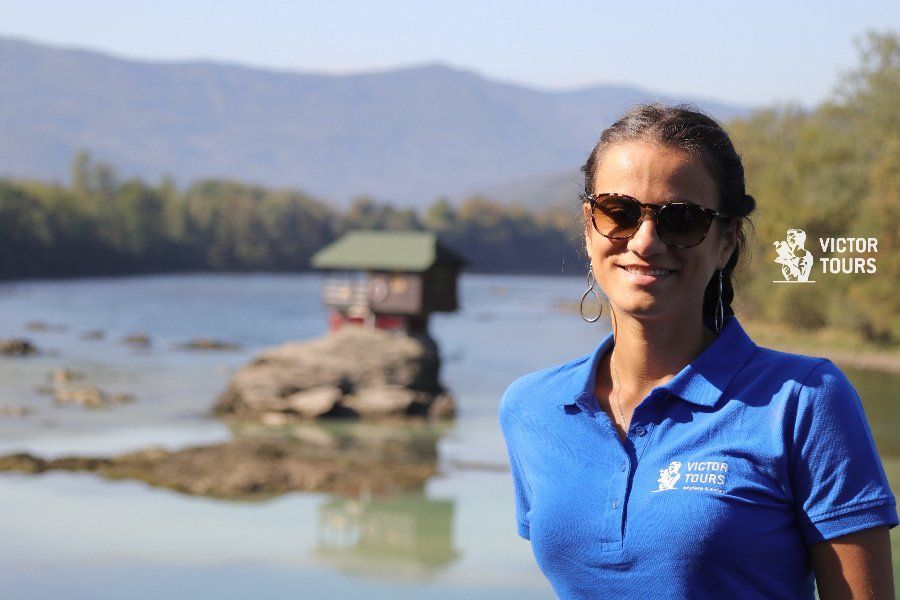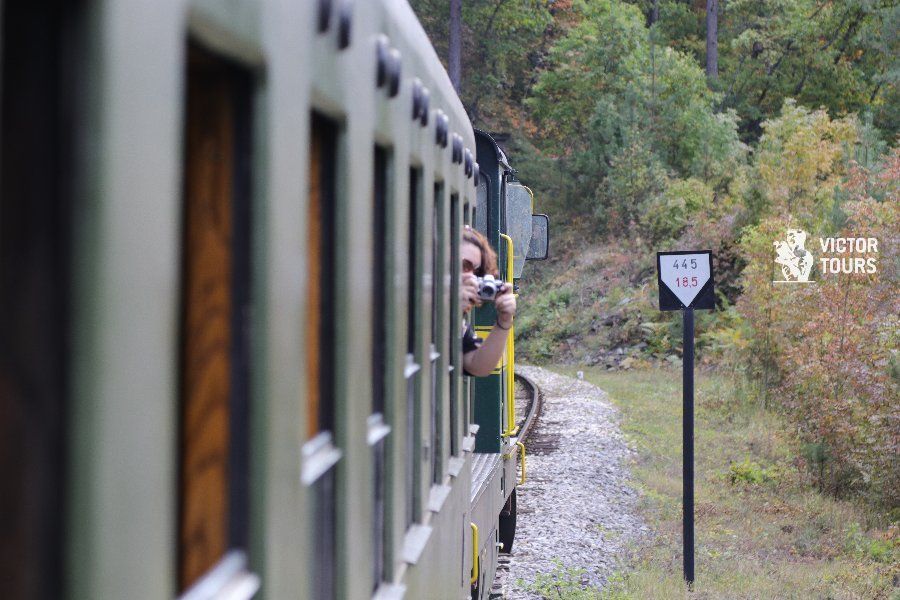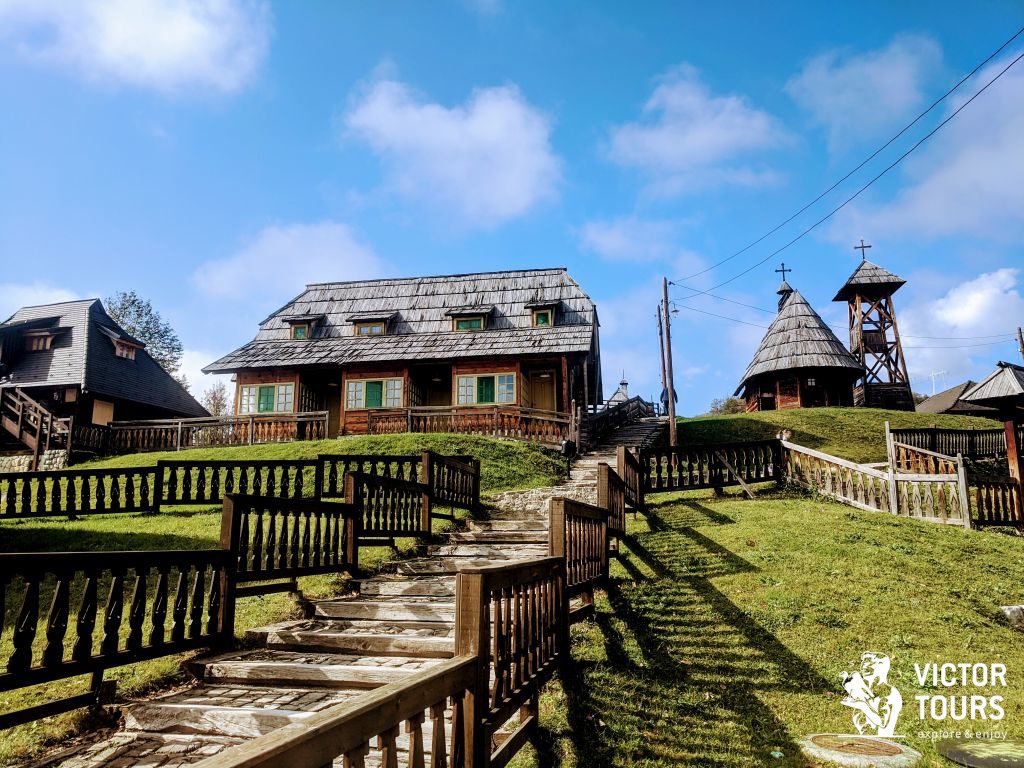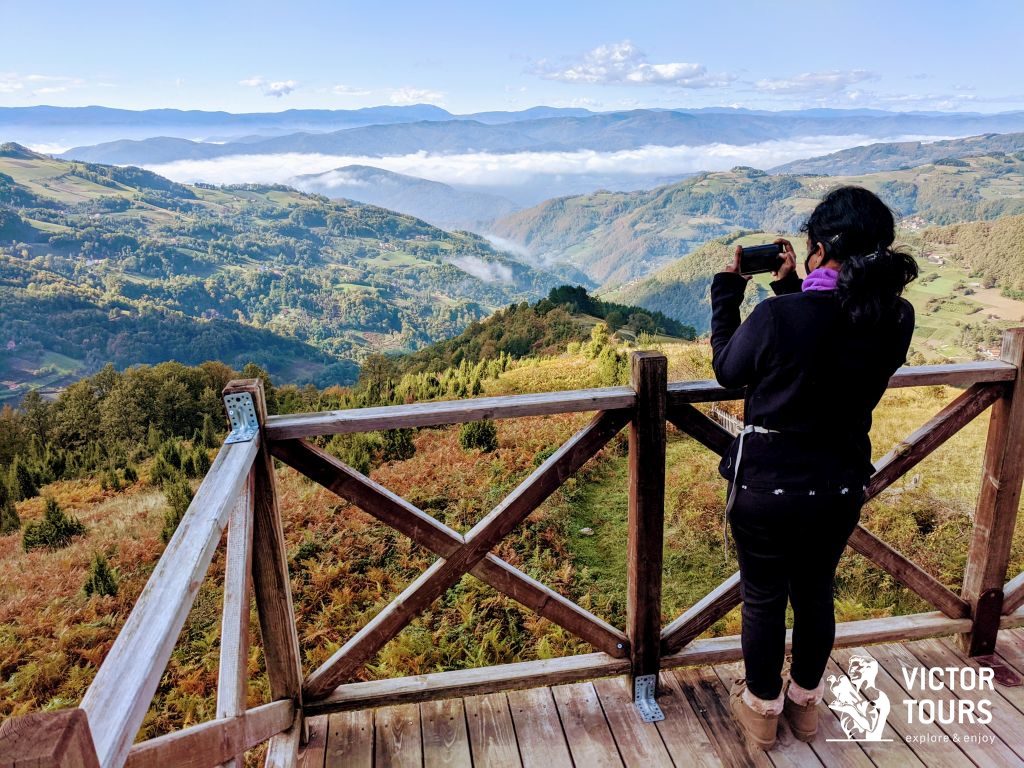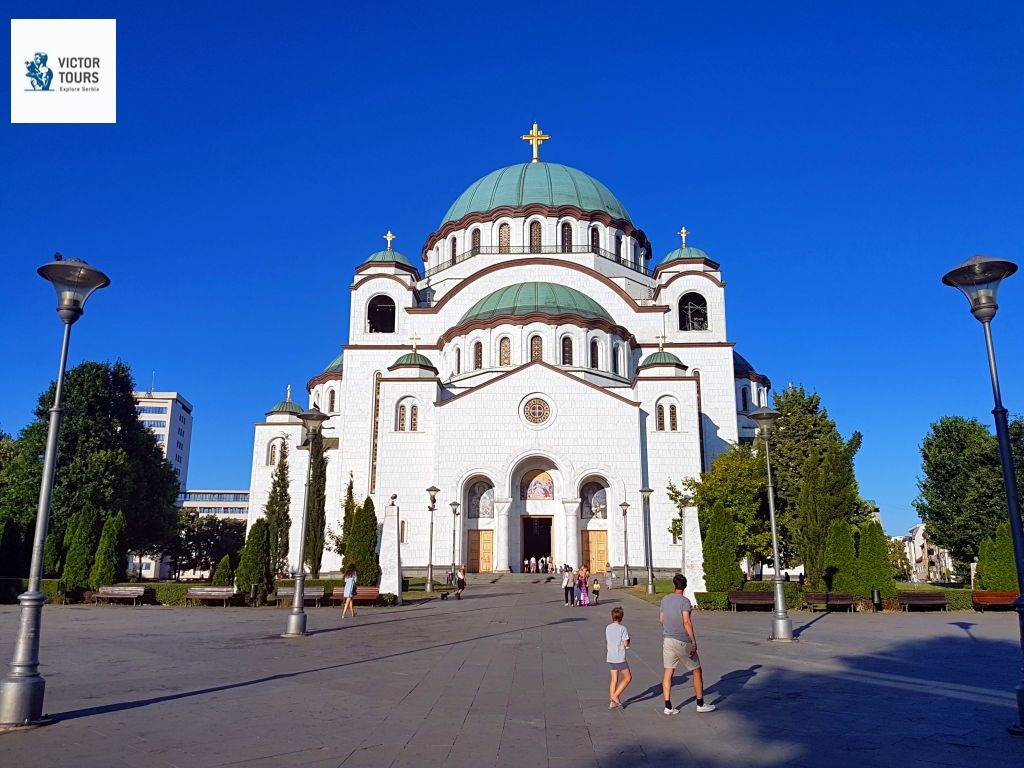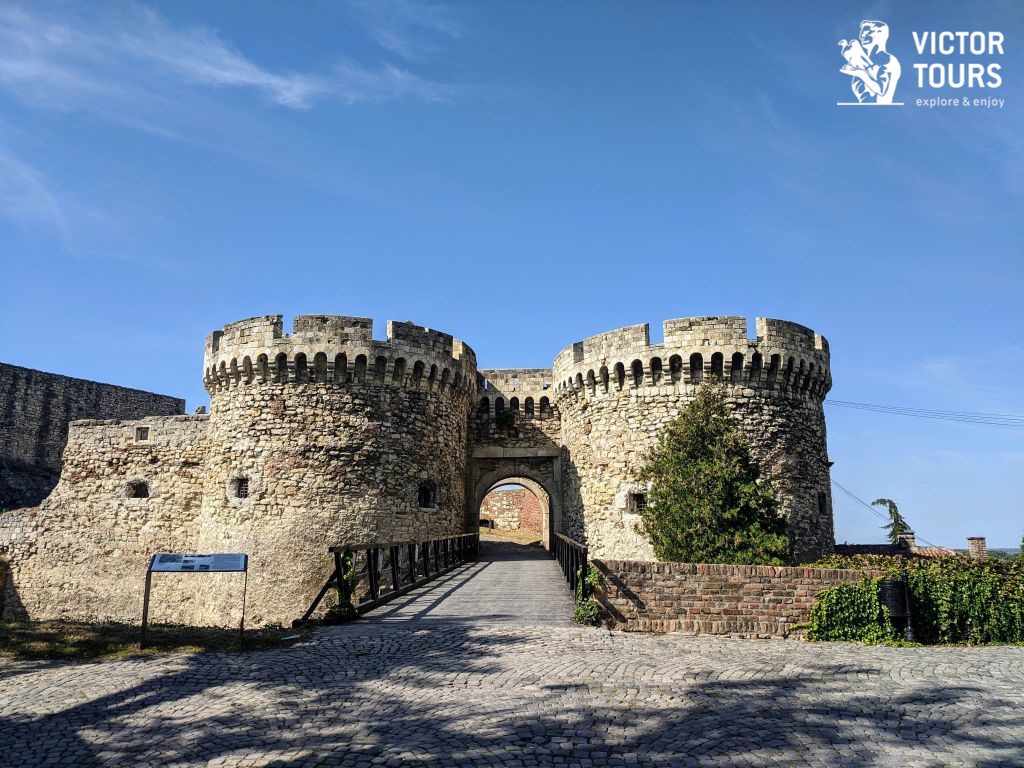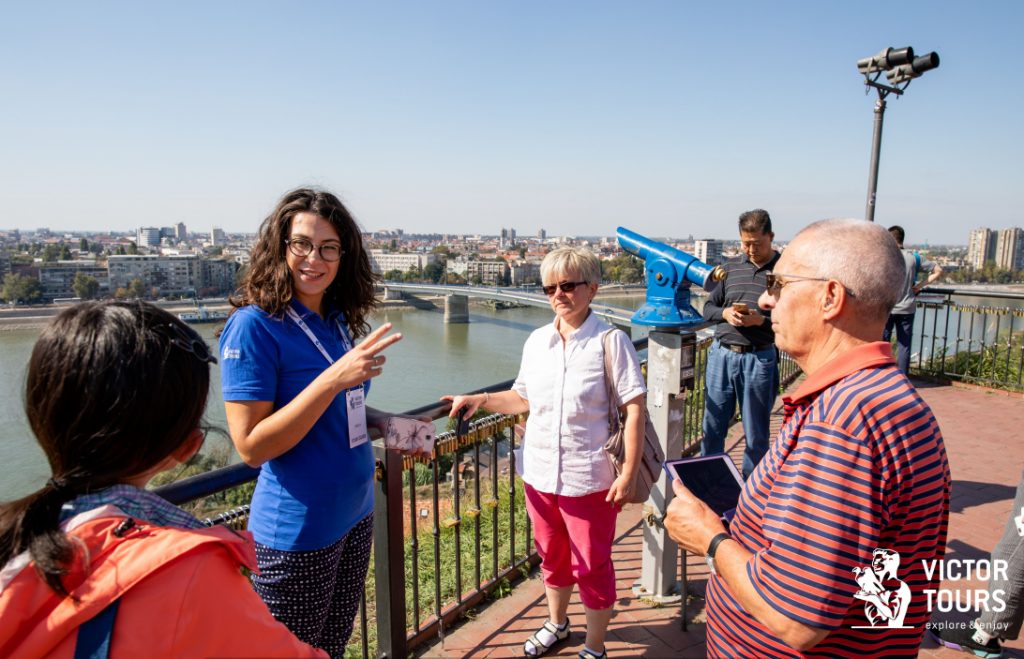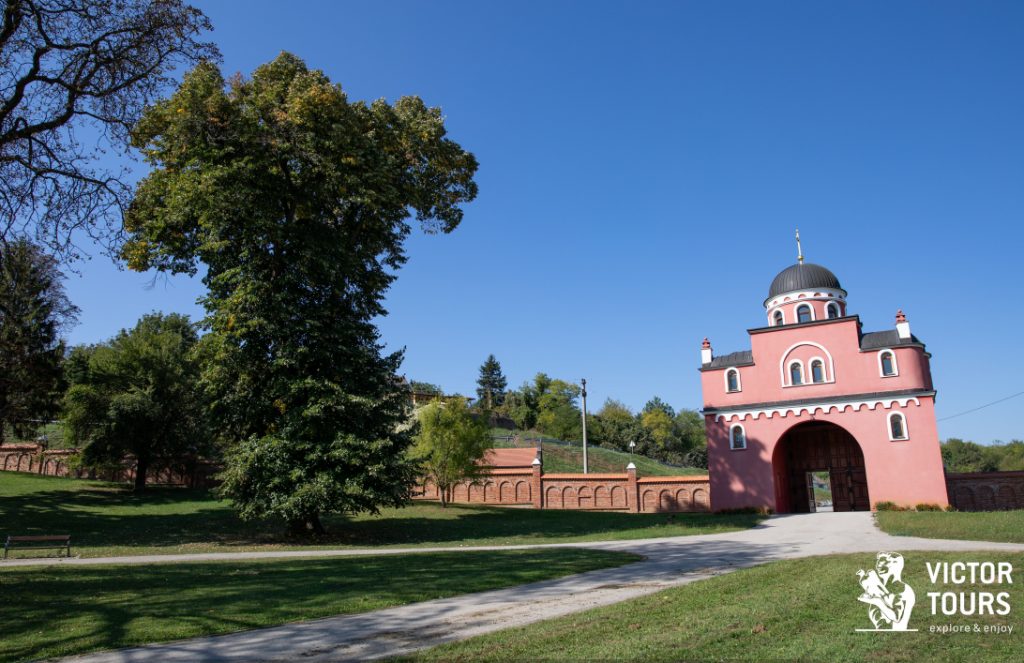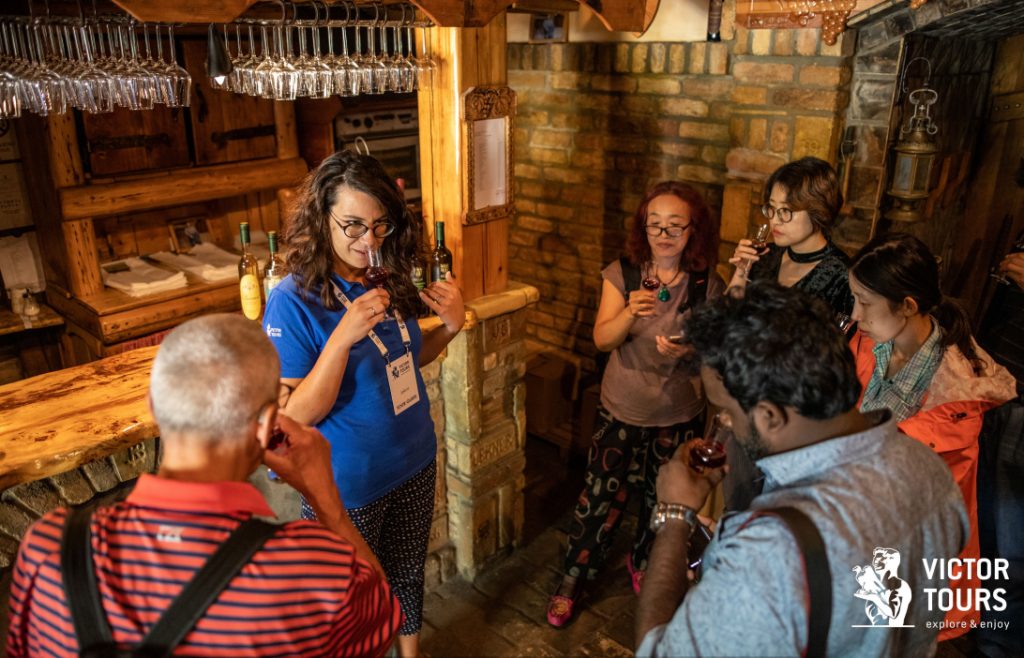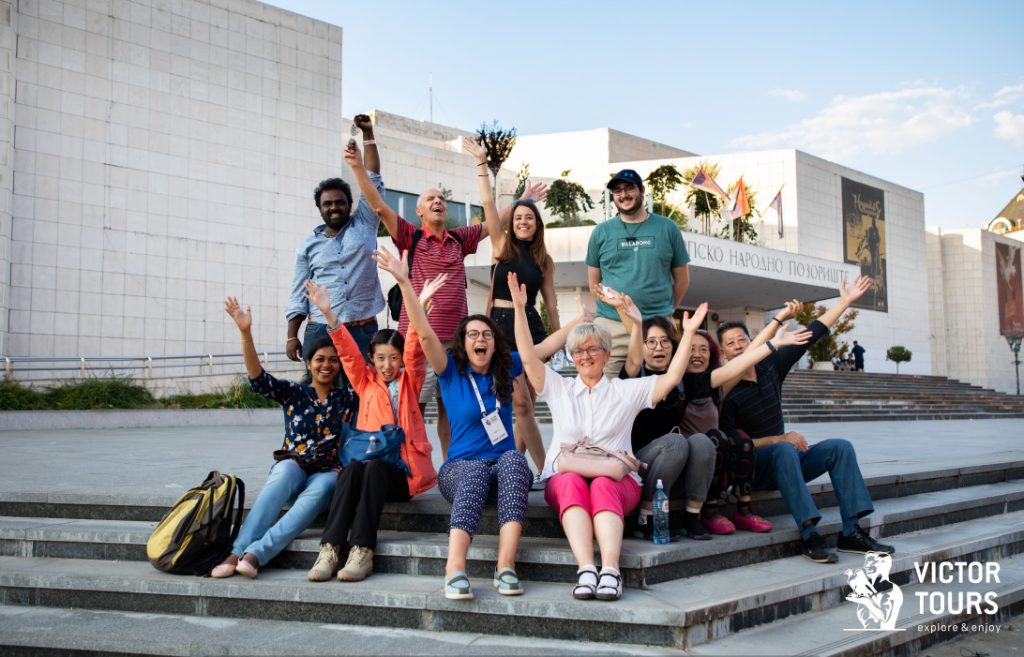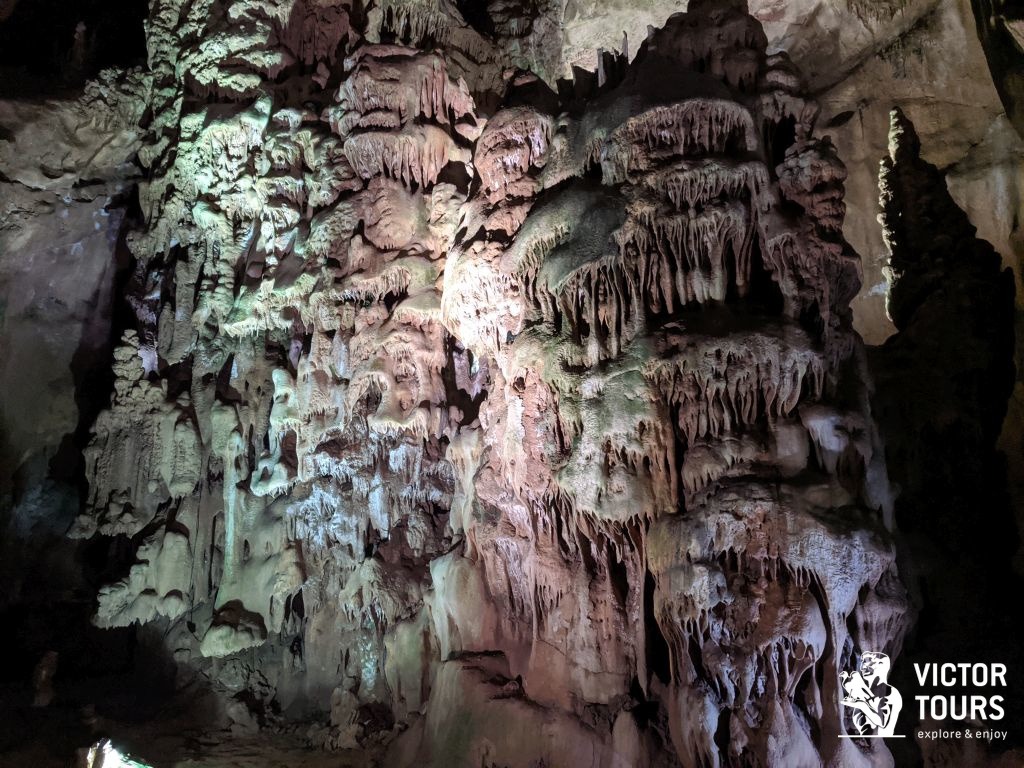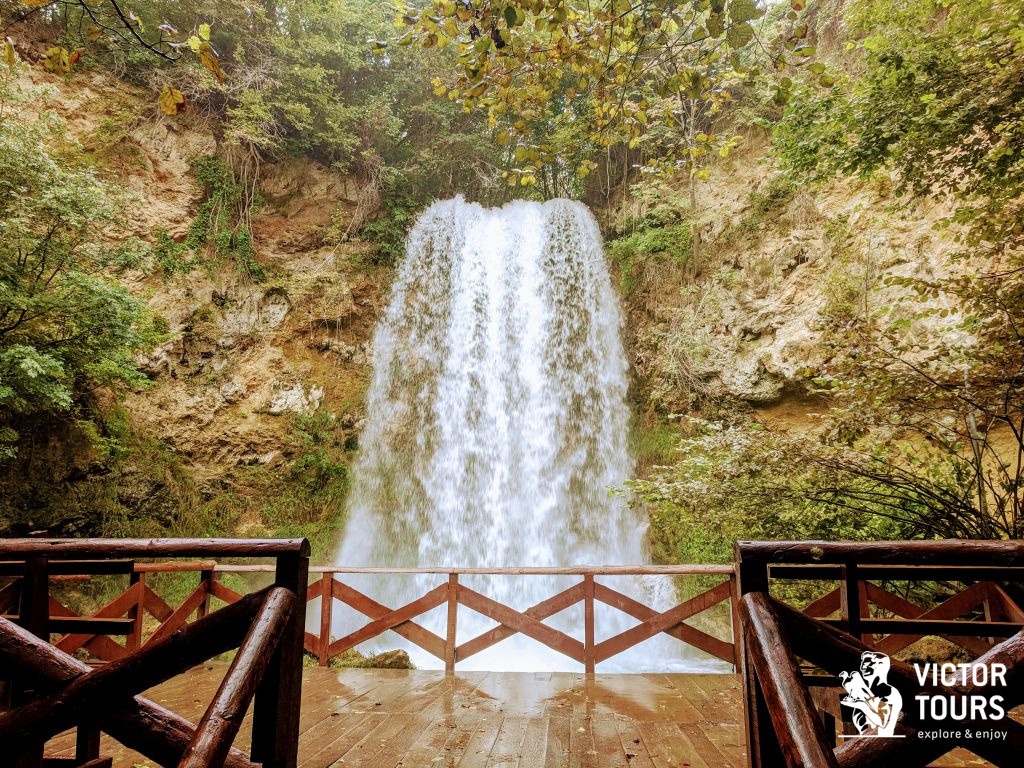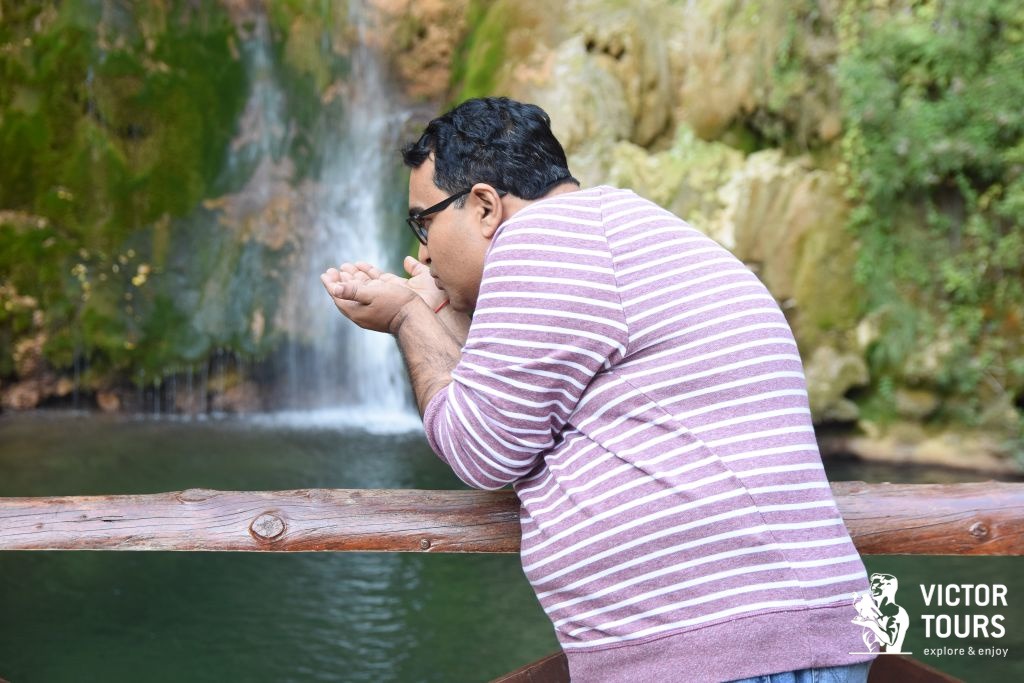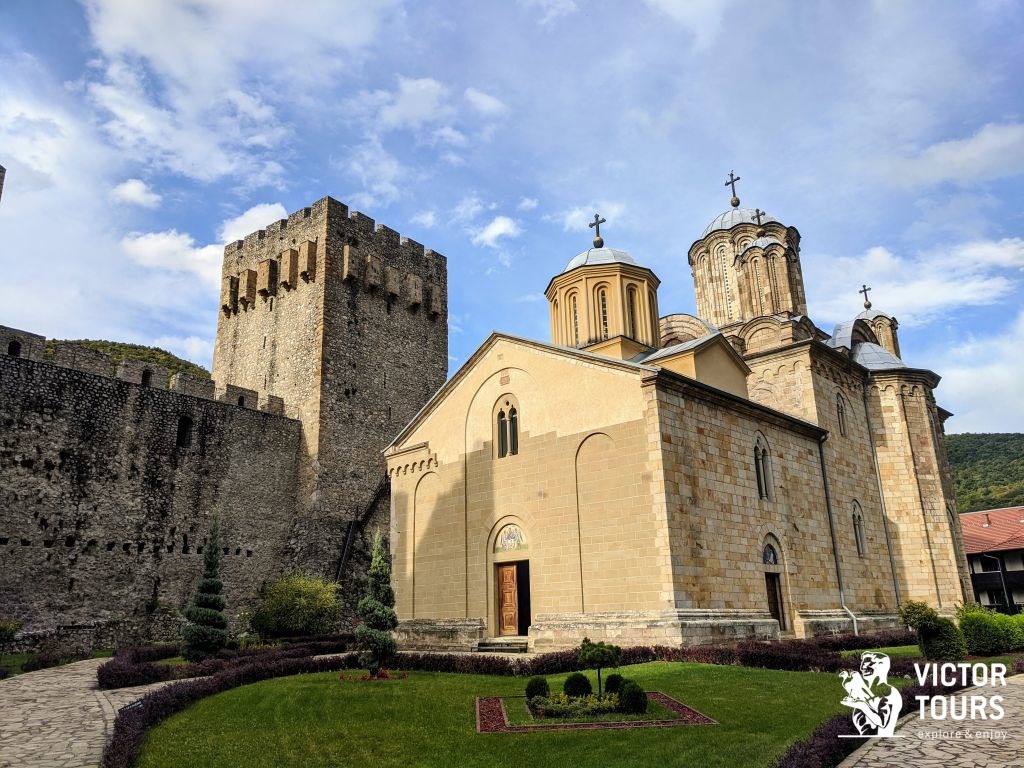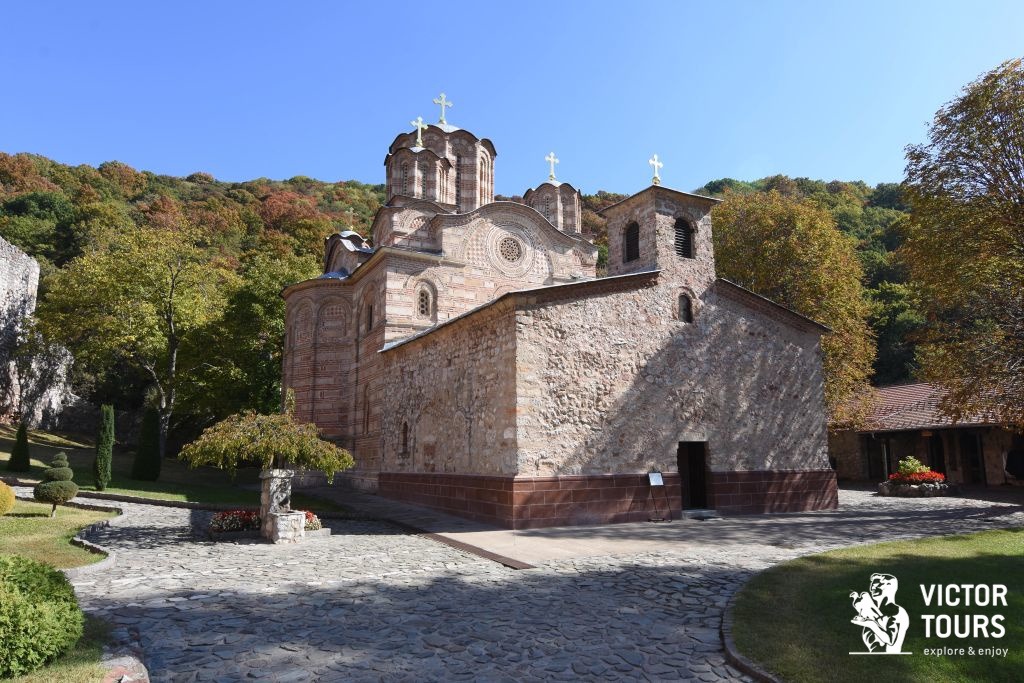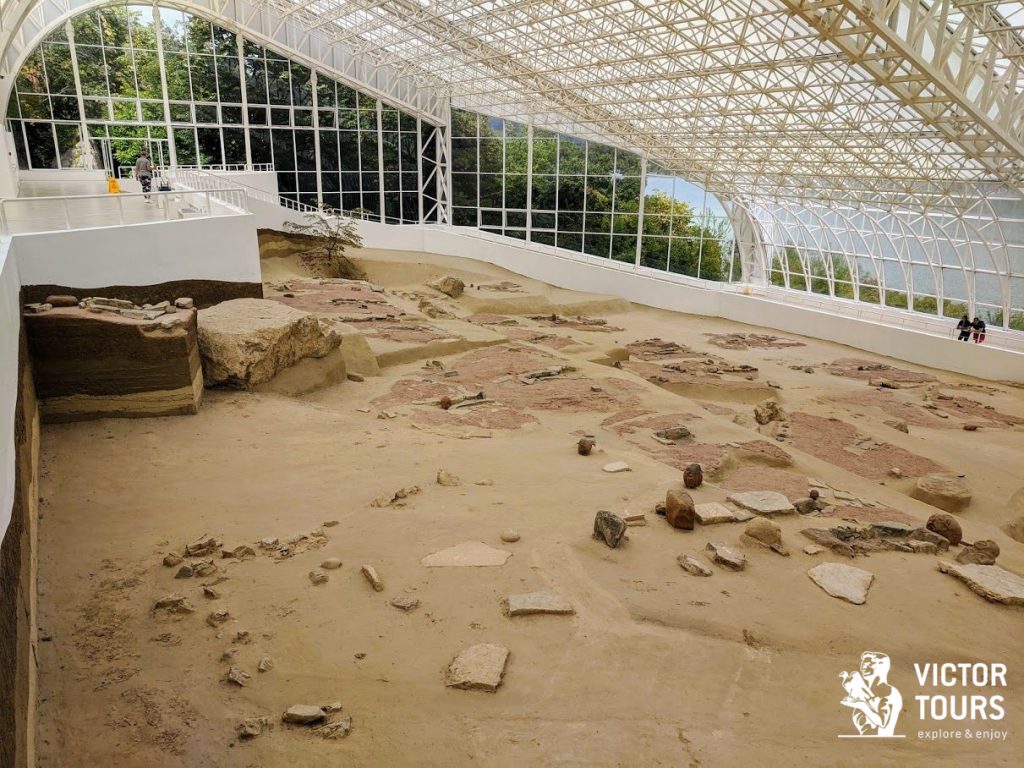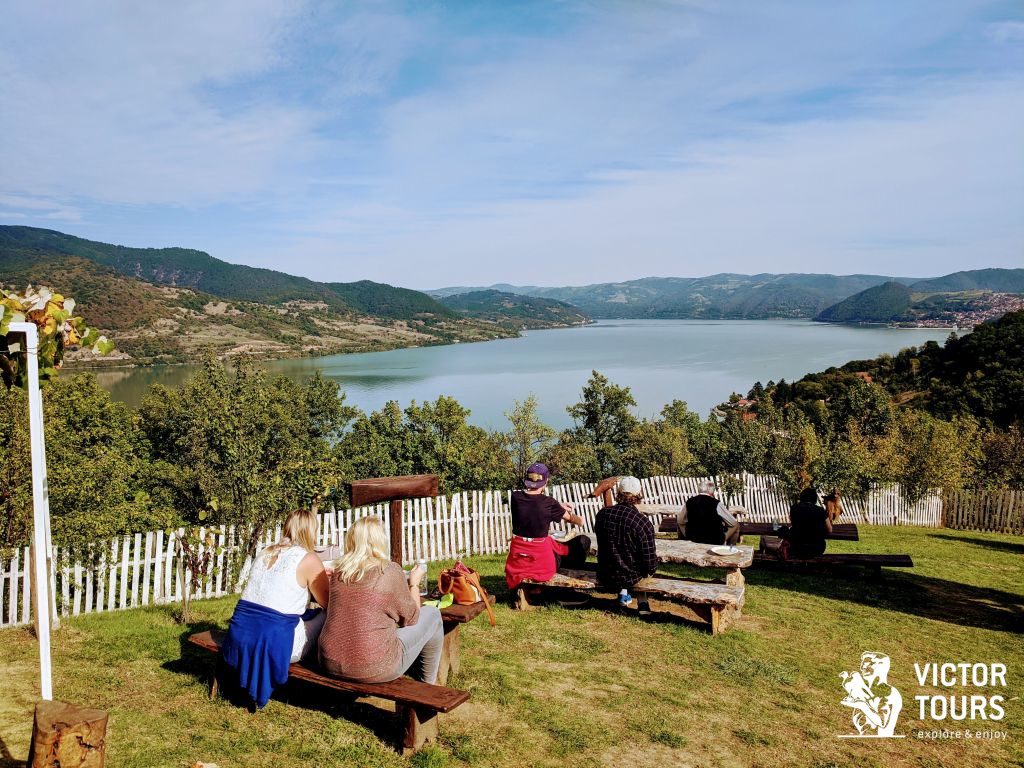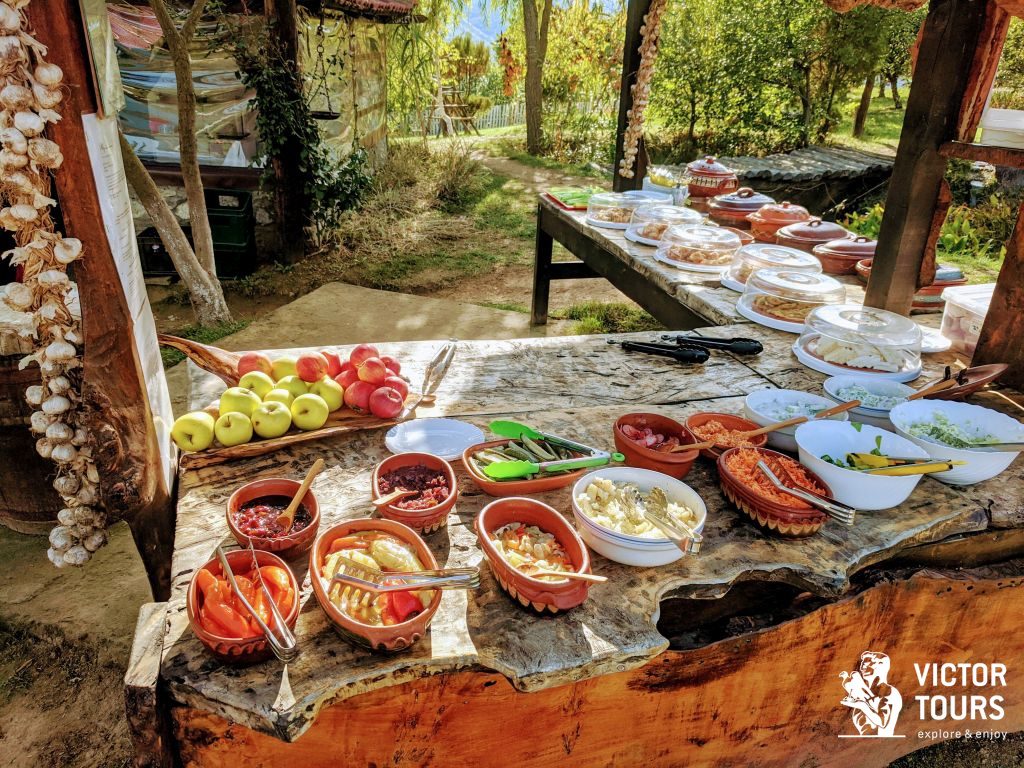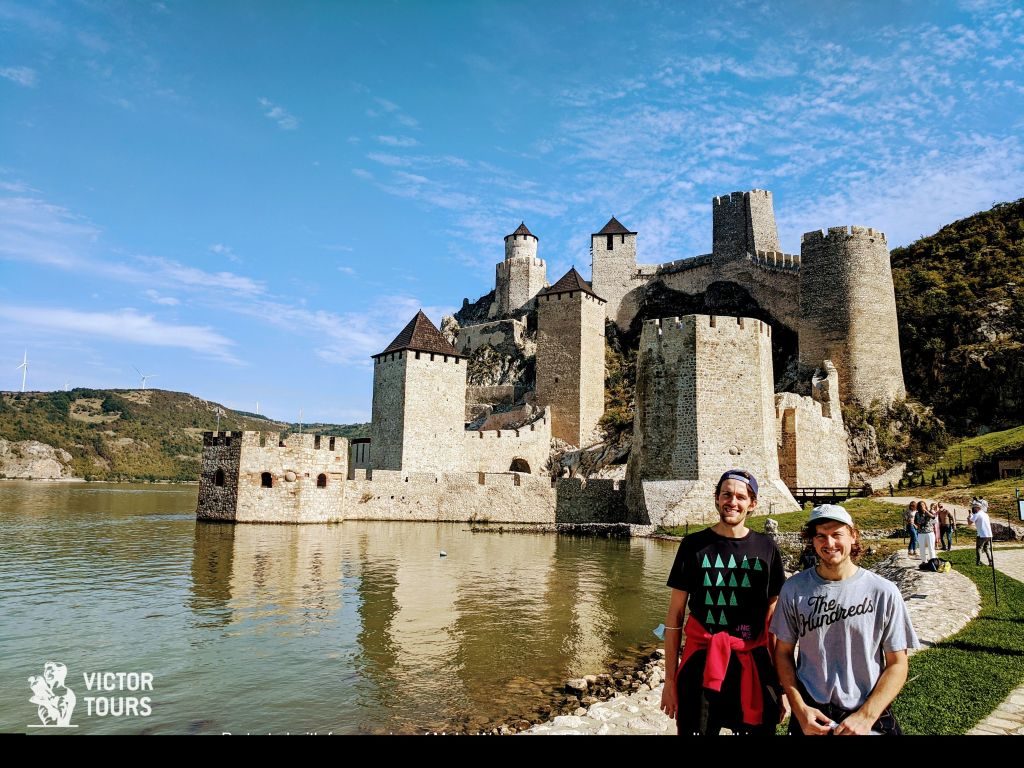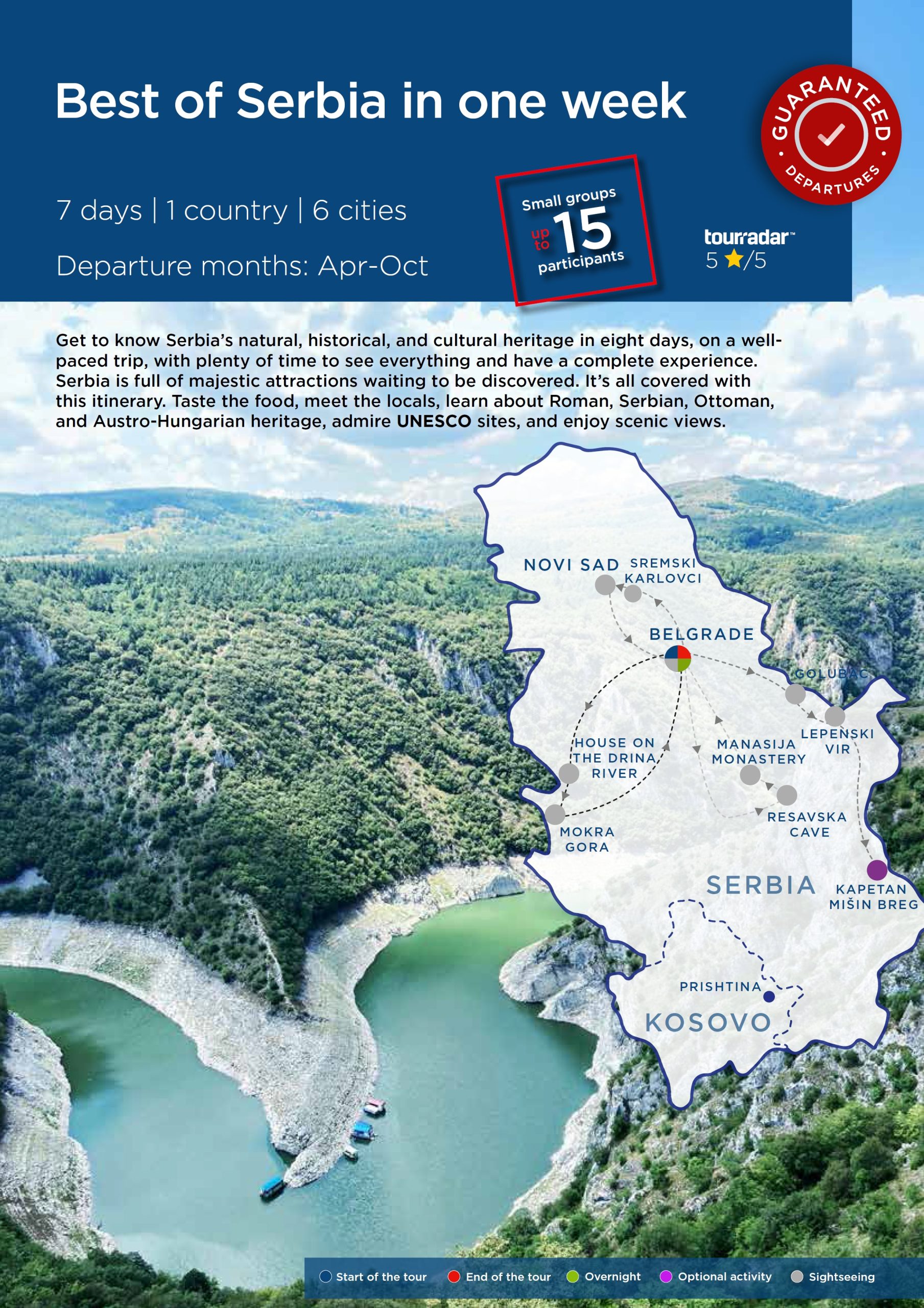Get to know Serbia’s natural, historical, and cultural heritage in seven days on a well-paced trip, with plenty of time to see everything and have a complete experience. Serbia is full of majestic attractions that are waiting to be discovered. It’s all covered with this itinerary. Taste the food, meet the locals, learn about Roman, Serbian, Ottoman, and Austro-Hungarian heritage, admire UNESCO sites, and enjoy scenic views.
Important note: this is a small-group experience, limited to 16 guests per departure. If you prefer a private tour, which will allow you to choose your dates, have more flexibility in choosing your itinerary, and have the comfort of having a vehicle and a guide just for yourself, please get in touch with us HERE.
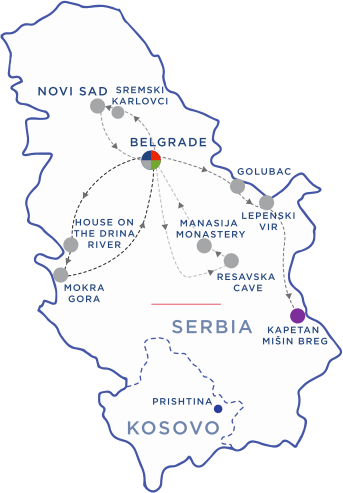

ITINERARY
Day 1 (Monday): Welcome to Belgrade
Arrival at “Nikola Tesla “International Airport.
Regardless of your arrival time on day 1 of the tour, we’ll wait for you at the airport. Our guide will meet you in the arrivals hall with your name on the signboard. In case your flight is delayed, there is no reason to worry. We will monitor your flight, and our guide will meet you accordingly. There are no additional charges for flight delays.
After a 20-minute ride, you’ll be in the city center. Check in at the hotel, and spend the rest of the day getting more familiar with Belgrade. You can walk around or follow your guide’s recommendation for dinner.
Overnight: Belgrade
IMPORTANT NOTE: If you arrive in Belgrade a few days before the tour departure, you can book additional nights with us, at the same hotel, for a surcharge of 50€ (Classic package) or 60€ (Upgraded package). Prices are per person, per night, in a double or twin room.
Day 2 (Tuesday): Belgrade Big Tour & optional Bohemian night
Kalemegdan Park & Belgrade Fortress
Your trip will begin with a pickup from your hotel/accommodation in Belgrade. We’ll not stay in the vehicle for a long time since our first stop is Kalemegdan, the oldest and largest park in the city center, and the magnificent Belgrade Fortress. Starting from Leopold’s Gate, we will pass by the remains of the Roman castrum – Singidunum and the medieval walls built upon it – Zindan Gate, Despot’s Gate, Jakšića Tower, all dating back to the 15th century. We will visit two Orthodox churches in this part of the fortress: The Chapel of St Petka and Ružica Church (Virgin Mary Church). Entering the Upper town (Gornji grad), we will see the magnificent sight of two rivers’ confluence: the Sava and the Danube.

The Victor monument
We will continue our walk through the Upper town: the Victor monument by world-renowned sculptor Ivan Meštrovic, one of Belgrade’s landmarks, the Roman well, the King’s gate, and the Sava promenade, the Damat Ali Pasha Tomb, Clock Gate, and Clock Tower. Passing by Military Museum and through Istanbul’s gate, we will leave the fortress behind us, entering Kalemegdan Park again. There is a Monument of Gratitude to France by Ivan Meštrovic in the park and many busts representing the famous Serbian man of letters. Here we’ll enter the vehicle again and continue with our tour.
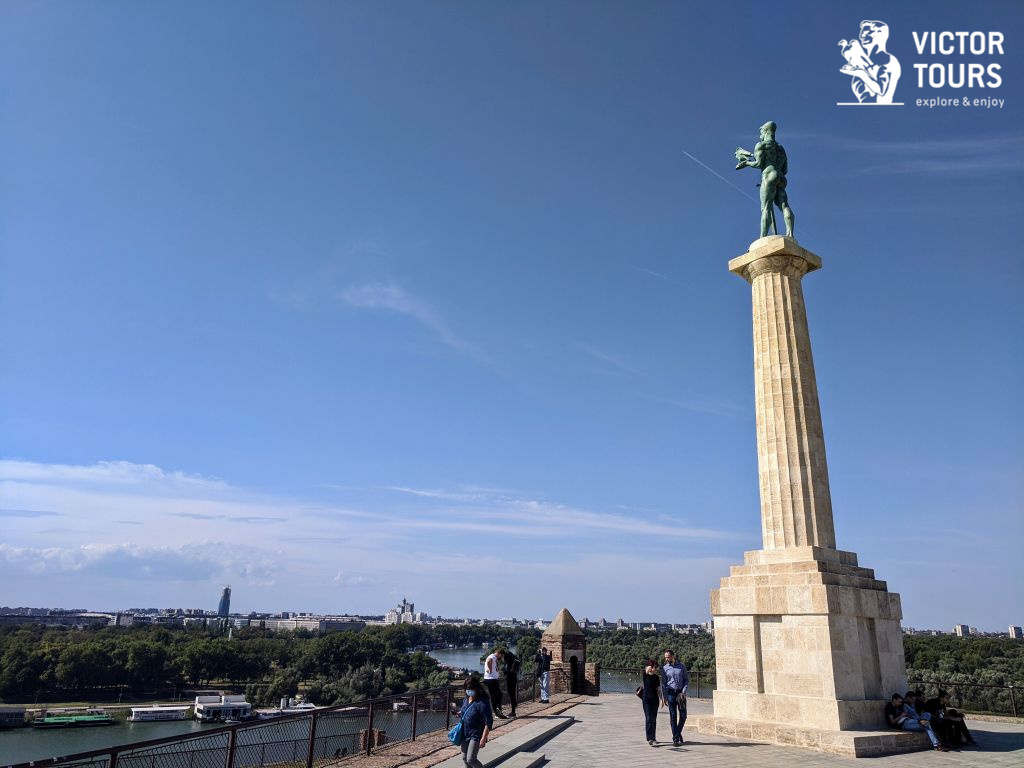
New Belgrade
Continuing with our tour, we’ll have a chance to see New Belgrade’s impressive modern architecture. Built as a new part of the town, after WWII and during the socialist regime, it has many remarkable buildings. Ex-Central Committee of the Communist Party, Federal Executive Council, also known as Palace of Federation, Genex Tower or Western Gate of Belgrade, Sava Center, one of the biggest congress halls in this part of Europe, etc. Even the famous MOMA museum from New York dedicated a special exhibition called “Toward a Concrete Utopia” to New Belgrade’s architecture. New Belgrade will show you this city’s different face, including the buildings architecturally similar to former Eastern block “brutalist” style and modern business buildings built in recent decades. Finally, we will pass by the restaurant “Novak,” owned by the famous tennis player Novak Đoković’s family, and the Belgrade Arena, the most important sports venue in this part of Europe.
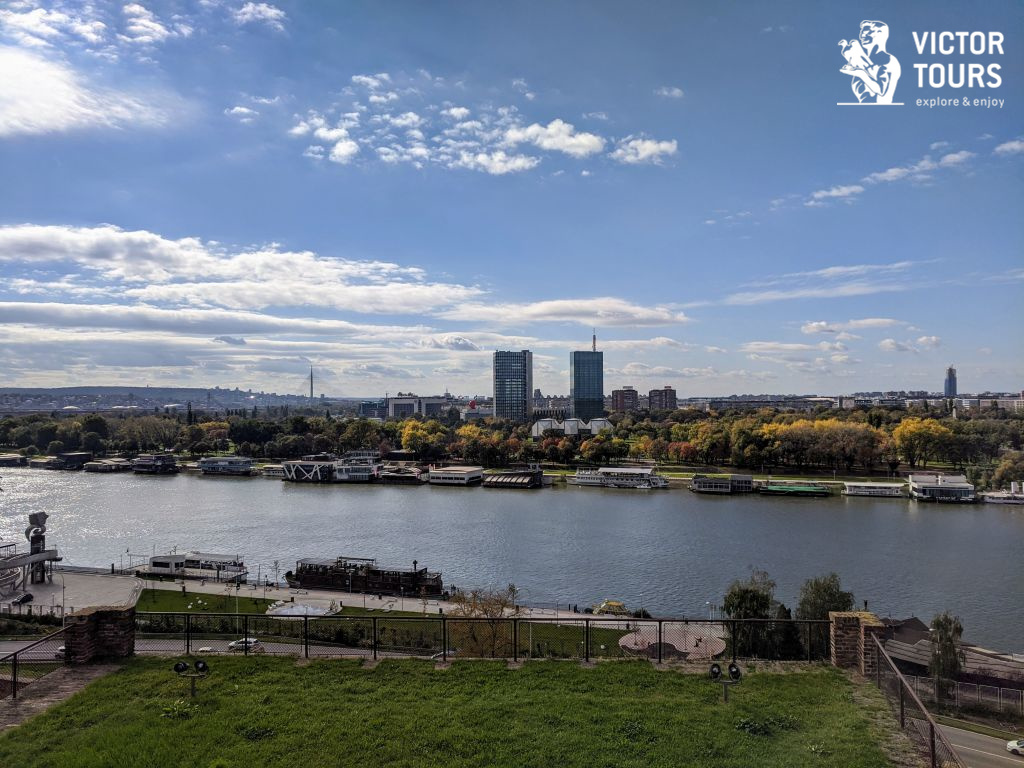
Zemun neighborhood
After New Belgrade, we’ll reach Zemun, the northern area of Belgrade, characteristic of its Central European appearance, charming quarters, cobblestone streets, and fish restaurants on the Danube River banks. We’ll pass by Avijatičarski Trg, where the old city of Zemun begins. With the massive monument to WWII heroes, this square is surrounded by Zemun’s oldest elementary school building and the Air Force Ministry, one of the finest examples of modernism in pre-war Yugoslav architecture. We’ll continue with our ride through the main street called Gospodska Street, where we have a chance to see some beautiful examples of Zemun architecture: the Post Office, Hotel Central, Town Museum, the House with a Sundial, etc.
Following, we’ll leave the vehicle on the Danube bank and start our walking tour through the heart of old Zemun. But before that, we’ll take a short coffee break to refresh and enjoy the view. We’ll continue along the bank of the Danube River – Zemun Promenade, where numerous old fish restaurants have nested under the shade of the century-old plane trees. Passing by the oldest Orthodox church of St. Nicholas from the 17th century, we’ll climb the Gardos Hill – the heart of Old Zemun. Its curvy cobblestone streets and small houses will give you the impression that Zemun is a melting pot of Mediterranean and Middle European cultures. When we reach the top of the hill, we’ll see the remains of the Zemun citadel that still stands together with The Millennium Tower in the center, Zemun’s central landmark. This romantic construction, built in a mixture of historical styles at the end of the 19th century, served to mark the most Southern point of the Austro-Hungarian empire. The majestic view from the top of the tower will leave you breathless: Zemun Old Town from above, but also the confluence of the two rivers and the Belgrade Fortress on the other side. We’ll go down Gardos Hill to the town center and reach the Main City Square, where an everyday market is situated. Old buildings, including the Bishop’s Office and the Roman Catholic Church of the Blessed Virgin from the 18th century, surround the square. We’ll finish our walking tour here, enter the vehicle, and continue our ride.
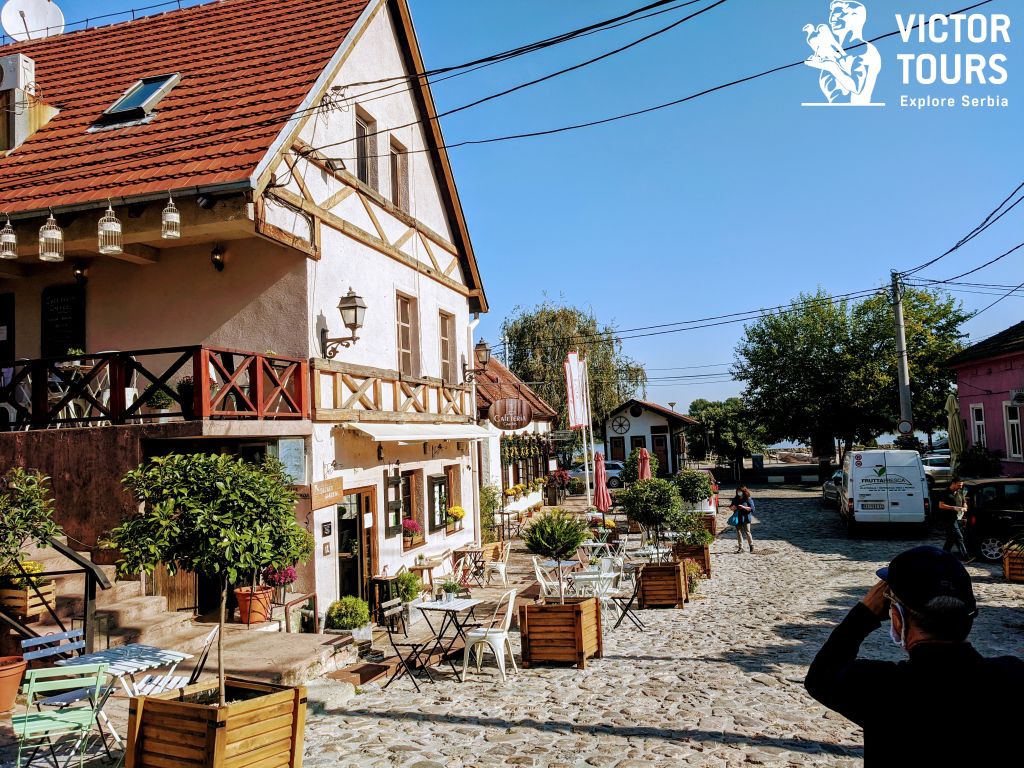
Lunch break
New Belgrade’s Goce Delčeva street is famous in the city, nicknamed “The Valley of Hunger .” The road is full of fast food joints, offering “pljeskavica and ćevapi”, pizzas, Chinese food, plates of pasta, and different delicious fast food sales arrangement. Over here, fast food here is prepared and sold in all shapes and sizes, suitable for everyone’s taste. Here we’ll make a 30 minutes lunch break.
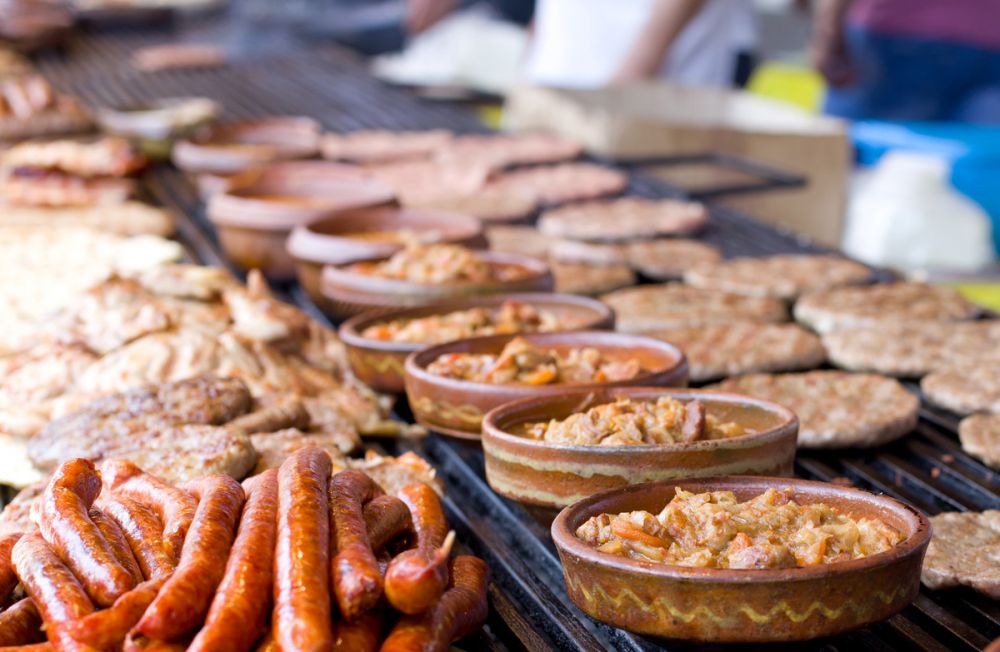
Dedinje neighborhood
After we cross the Gazela Bridge, we’ll head for Dedinje – Belgrade’s most luxurious residential area. Here, we’ll see some of the most beautiful mansions in the city, perfectly nestled in the greenery and serenity of Topčider Hill. Your guide will give you some interesting information about the properties’ history and what was happening with them during the very turbulent 20th century. We’ll see the country’s biggest football stadium, “Rajko Mitić Stadium”, the home of Red Star Belgrade. Red Star is the last club from Eastern or Southern Europe to win the prestigious Champions League. Their biggest competitor, Partizan Belgrade, has a stadium just across a small hill. Their rivalry is lasting for more than 70 years.
Saint Sava Temple
Coming from Dedinje, we’ll visit the Vračar area, where we can see one of Belgrade’s most prominent landmarks – The Church of St. Sava (also known as St. Sava Temple), one of the largest Orthodox churches in the world. The Temple of St Sava has an enormous dome that you can see from all over the city. Size apart, the church is undeniably a highly impressive structure. Construction began in the 1930s at the site where the occupying Ottoman forces burned the relics of St. Sava (1175-1236). St Sava was the founder and the first archbishop of the independent Serbian Orthodox Church, and Serbians widely recognize him as one of the most important figures in Serbian history. Built in the Serbian-Byzantine style, the church occupies an area of 3500 m² at floor level, with an additional 1500 m² in the three galleries on the first level. At its highest point, the dome is 70 m in height, while the central gilded cross is an additional 12 m high, giving the Cathedral a total height of 82 m.
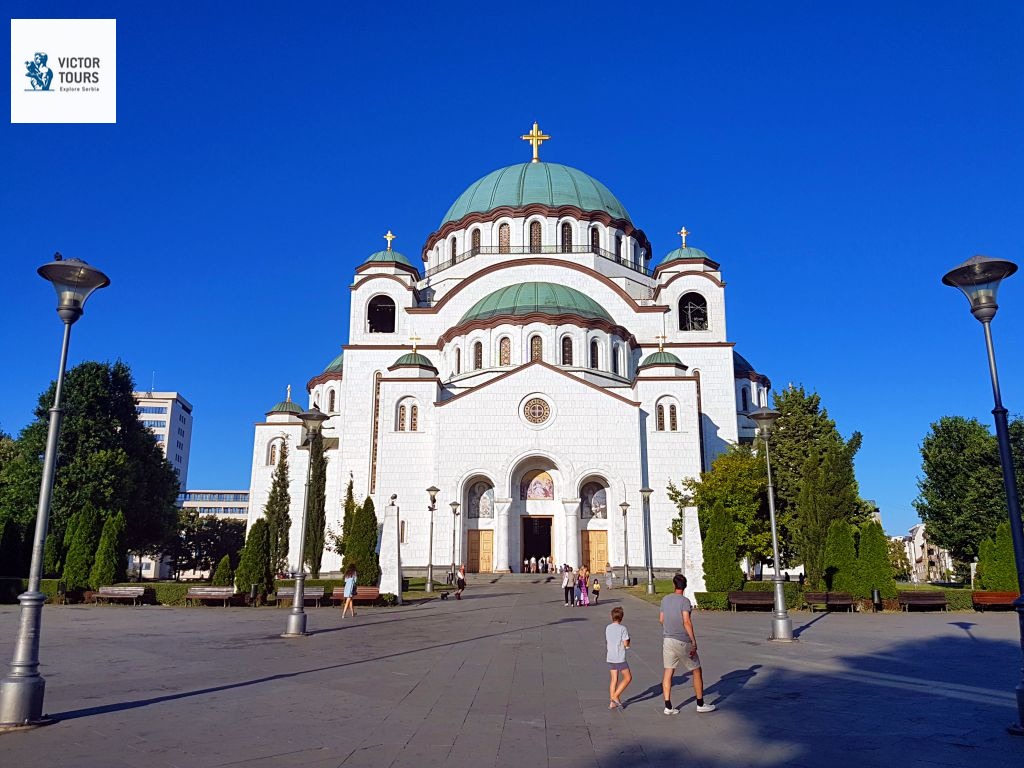
Slavija square
When we finish with the Temple, we’ll enter the vehicle one more time. Through Slavija Square, we will enter Nemanjina Street with almost all state governmental institutions: Government Building, the Ministry of Foreign Affairs, the General Staff of Serbian Army, the Ministry of Railways, the Ministry of Finance, and the State Court, etc. – all being beautiful examples of Belgrade’s pre-war architecture.
The National Assembly and Terazije Fountain
After that, we’ll ride through Kralja Milana Street, the city’s artery where some significant buildings are situated, such as the Old and New Royal Palaces. We’ll pass by Nikola Pasic Square, with a monument to the first Prime Minister of the Kingdom of Yugoslavia. We’ll stop in front of the Parliament Building, where we will take a short break to take pictures. We will also see the Old and New Royal Palaces and hear stories about the two dynasties that ruled Serbia in the 19th and 20th centuries. Following, we’ll reach Terazije Square with its recognizable 19th-century white stone fountain and one of the most beautiful buildings in the city – the Moskva Hotel.
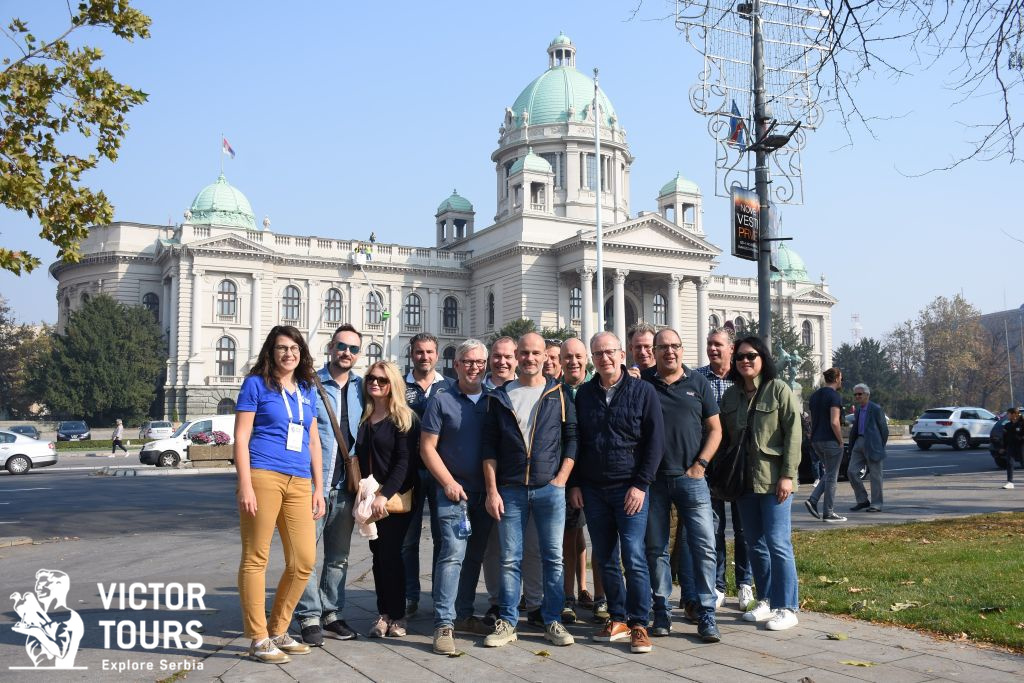
Republic Square
We’ll continue our ride and reach Republic Square, the heart of the capital, where the city’s most prestigious cultural institutions are situated. Here you will hear information about the most important buildings surrounding the Square: the National Museum and National Theatre, and a short explanation of why Prince Mihailo is one of the most important figures in Serbia’s modern history. Here we will see the National Museum and the National Theater and Opera buildings, with an equestrian monument to the most important city and state ruler from the 19th century – Knez Mihajlo.
That will be the end of our tour, and after Republic Square, we’ll drop you off at your hotels.
Optional Bohemian night
In the evening, visit the Old Bohemian Quarter of Skadarlija, frequently compared to Montmartre in Paris, both in appearance and artistic atmosphere. It’s a perfect opportunity to familiarize yourself with traditional Serbian cuisine and the famous Belgrade nightlife. (Optional: 30€ per person)
Overnight: Belgrade
Day 3 (Wednesday): Western Serbia: Šargan Eight Train, The Wooden Town & The House on Drina River
Our tour starts from your accommodation, and we head toward Western Serbia, known for its wild and untouched nature, tasty cuisine, and friendly and hospitable people. Two and a half hours ride we’ll spend enjoying the beautiful landscapes and listening to interesting stories about this part of the country.
Gate of Podrinje viewpoint
Our first stop is one of the most famous viewpoints in the area, called “Kapija Podrinja.” From here, you can enjoy a breathtaking view and admire the stunning scenery made of surrounding mountains and the Drina River. After a short ride, we will reach our next stop, Bajina Bašta, a small town in the foothill of Mt. Tara.
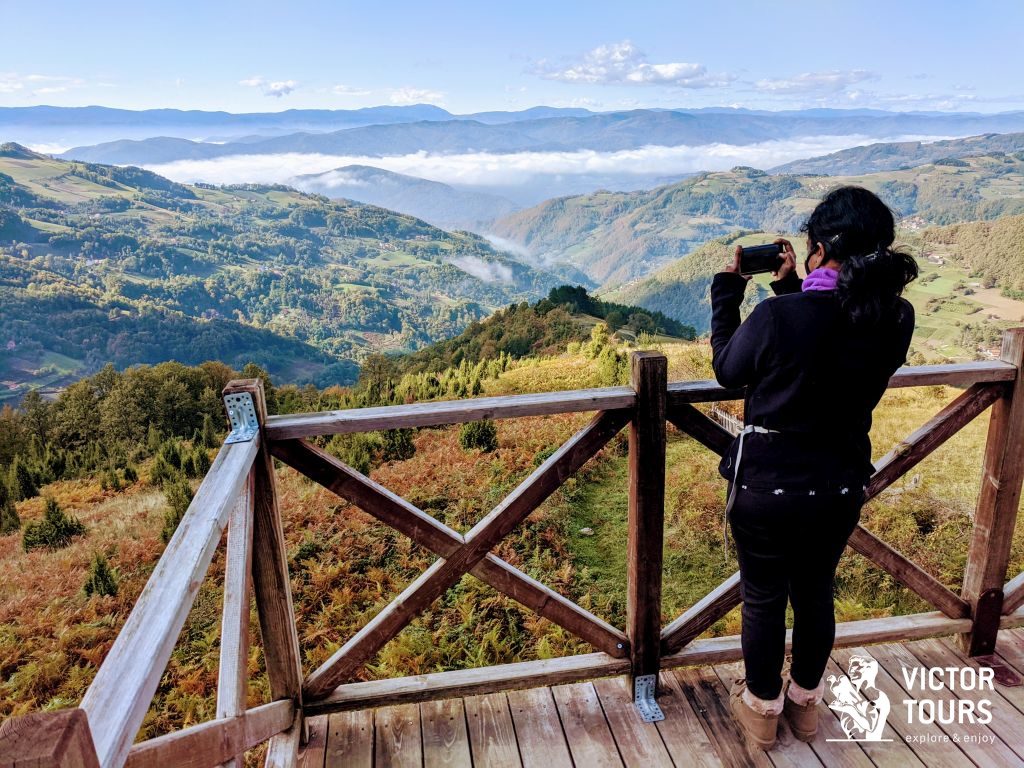
The House on Drina River
Here, we will see the world-famous attraction, “The House on the Drina,” an isolated house made of logs on a river stone. A photograph of the structure was featured in National Geographic’s ‘Photo of the Day’, and not too long after that, this charming spot became one of the most photographed sights in the Balkans.
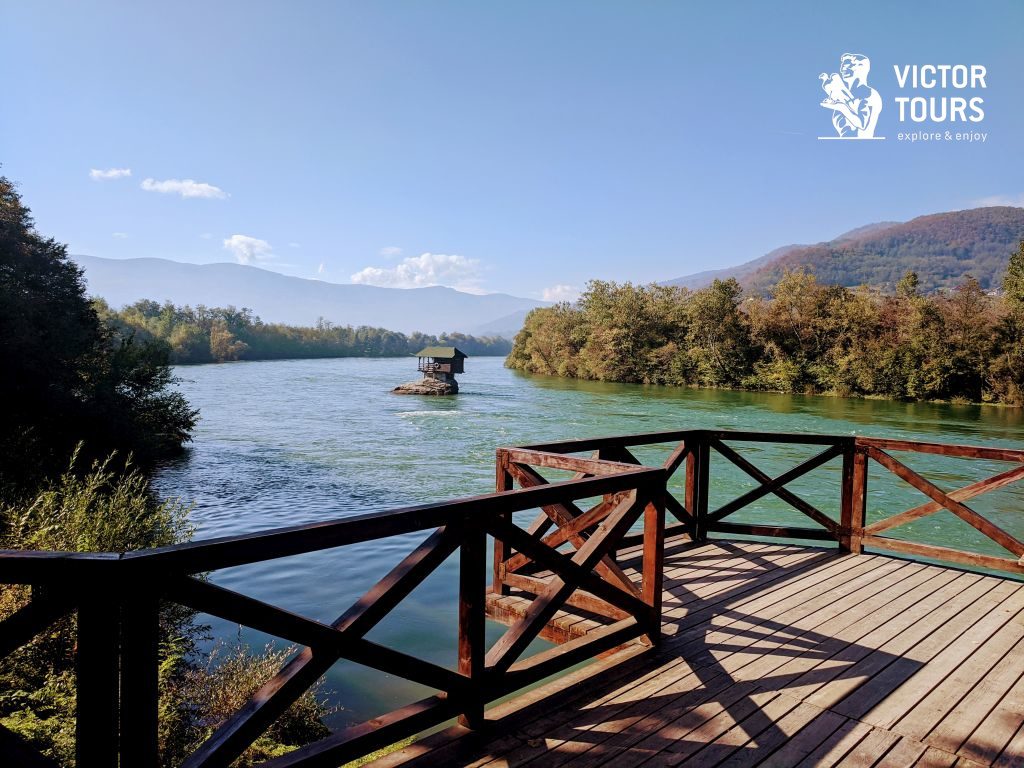
Šargan Eight Train
We will leave the house behind us and continue our trip just in time for the departure of the famous Šargan Eight scenic train. Unique narrow-gauge railway nowadays serves only for amusement. We will pass and stop at several viewpoints during our ride, from which one can see fabulous views over Mokra Gora. Authentic cars with wooden seats, wood-burning stoves, and characteristic rattling sounds will take us back to 1925 when this railway was put into operation and made a connection between Belgrade and the Adriatic Sea.
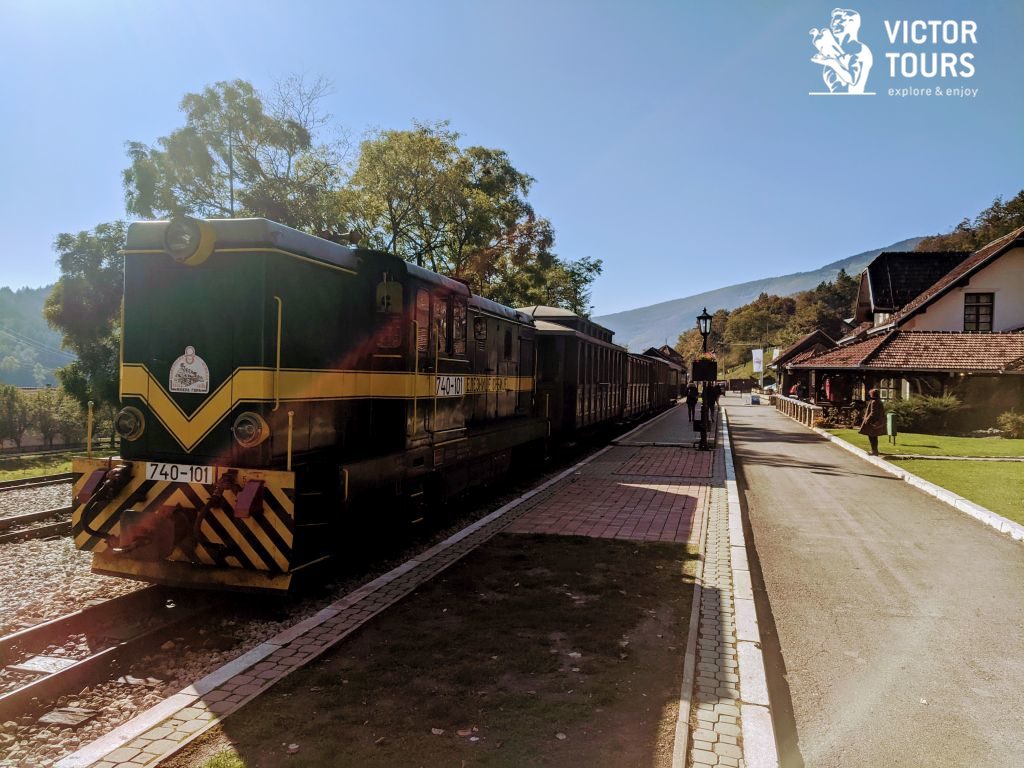
After almost two and a half-hour ride, we return to the departing station, where we continue our journey to the nearby Mećavnik, or Drvengrad (Wooden City).
The Wooden Town
The famous director Emir Kusturica (two-time Palme d’Or in Cannes winner) decided to build it during the shooting of his film “Life is a Miracle.” He chose to convey ruined wooden chalets from the mountain’s slopes to restore them, equip them with luxurious facilities, and form a new settlement.
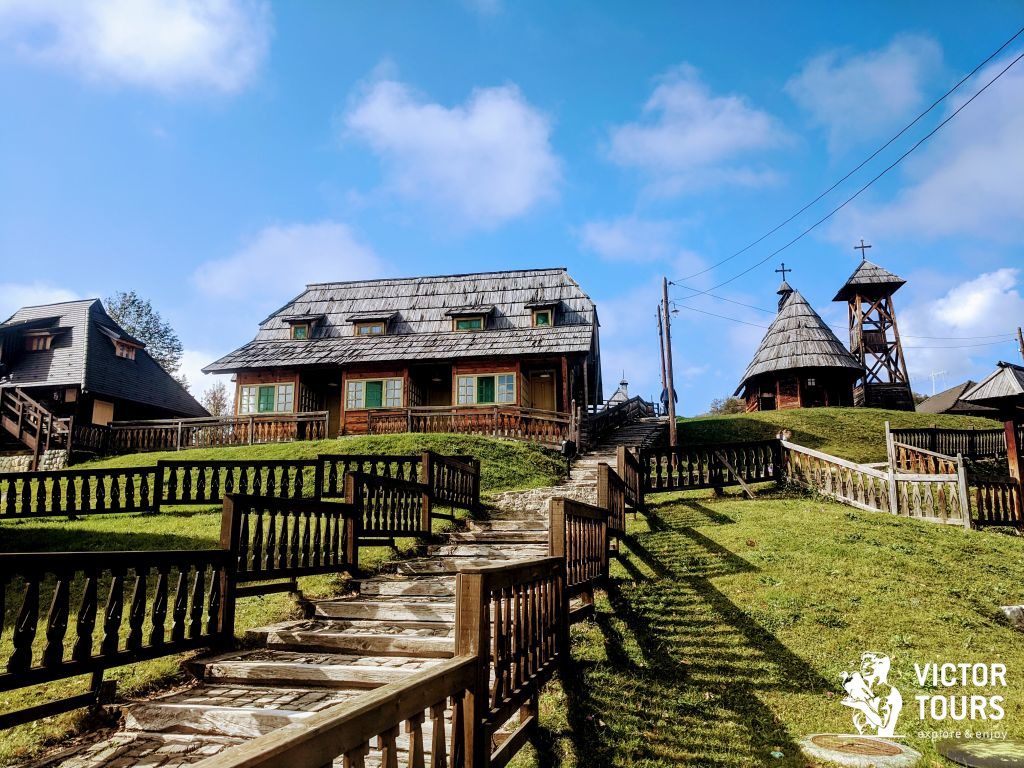
Here we will make a stop to enjoy a traditional lunch made of specialties of the very famous cuisine of Western Serbia, irresistibly delicious and very piquant (not included).
After the meal, we will head back to Belgrade to arrive late in the evening.
Overnight: Belgrade
Day 4 (Thursday): Along the Danube: Golubac Fortress & Iron Gate Gorge
Our tour starts from your accommodation, and we will head toward Eastern Serbia. Two hours of the ride we’ll spend enjoying the beautiful landscapes and listening to interesting stories about this part of the country.
Golubac Fortress
Our first stop is the Golubac fortress, a defensive complex used to defend many kingdoms through the centuries. Golubac is the perfect fairy-tale castle, wonderfully set off by its location in the rugged landscape at the head of Đerdap Gorge. There are nine towers in all, each between 20 and 25m high, combined with the interesting position of the fortress leaning over the Danube; they make Golubac undoubtedly one of the most beautiful castles along the 2850km Danube odyssey from source to the Black Sea.
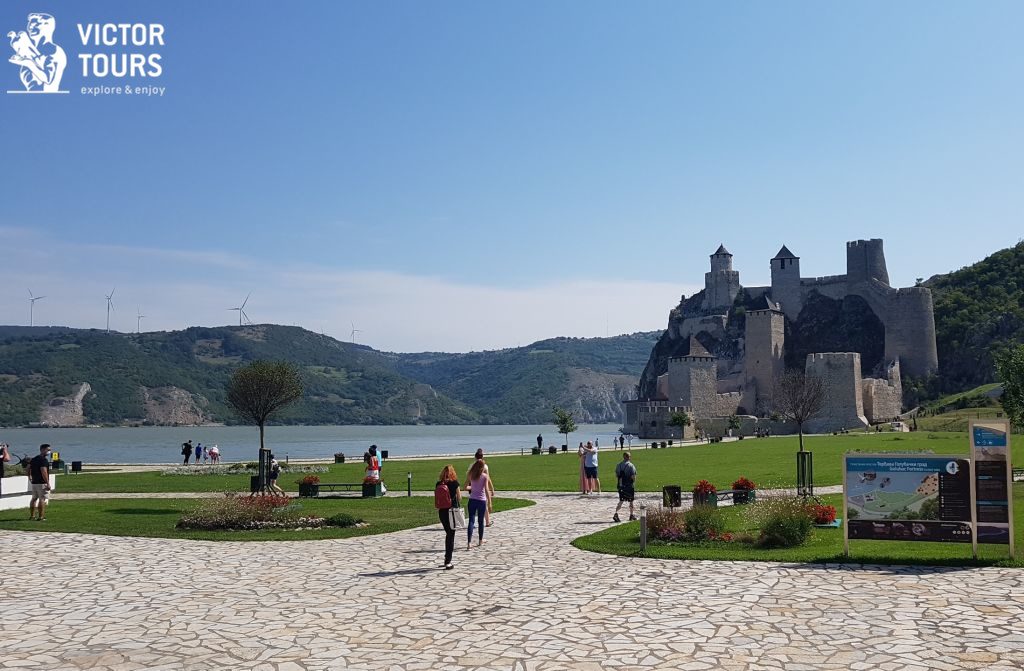
Lunch break
After the fortress, we will stop at a unique, authentic restaurant with a fantastic view overlooking the Danube to enjoy a traditional lunch made of specialties of Eastern Serbian cuisine (not included).
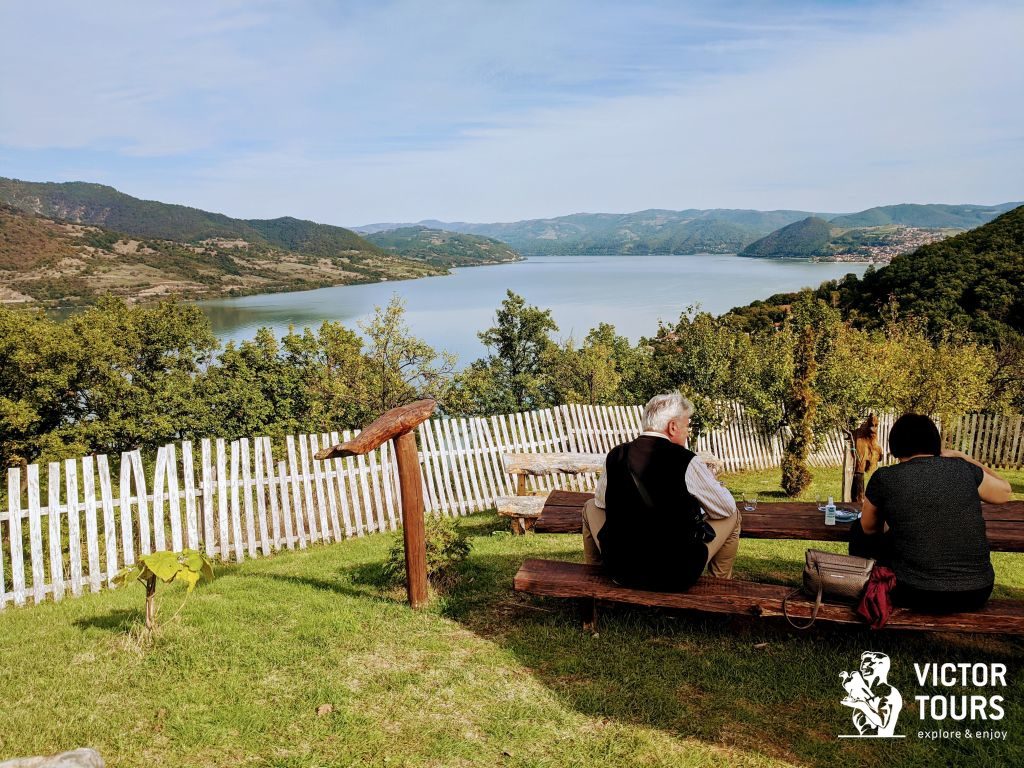
Danube boat ride
After lunch, we will continue to the highlight of this excursion: a breathtaking tour through the Iron Gate (Gvozdena Kapija), where the Danube River is at its narrowest (just 140 meters) and deepest (90 meters). This natural marvel marks the start of the Great Kazan and Đerdap Gorge, once home to the first signal balloon station before the Đerdap Hydroelectric Power Plant.
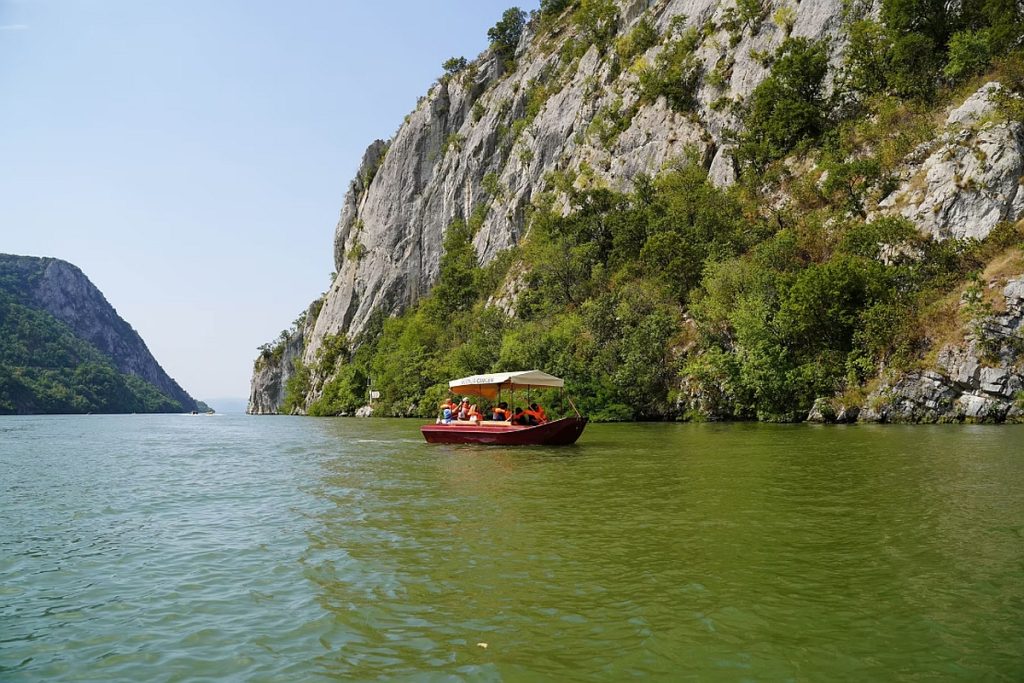
We will first cruise along the Romanian shore, visiting Veterani Cave, dating back to Roman times. It once sheltered elite Dacian soldiers who ambushed Roman galleys to reclaim treasures taken by Emperor Trajan.
As we sail downstream, we pass New Dubova, a village rebuilt after the dam submerged the original. Nearby is the Mraconia Monastery, a 15th-century Orthodox nunnery, beside the massive rock statue of King Decebalus. Carved between 1994 and 2004, it’s the largest stone sculpture in Europe and stands as a powerful tribute to Dacian heritage.
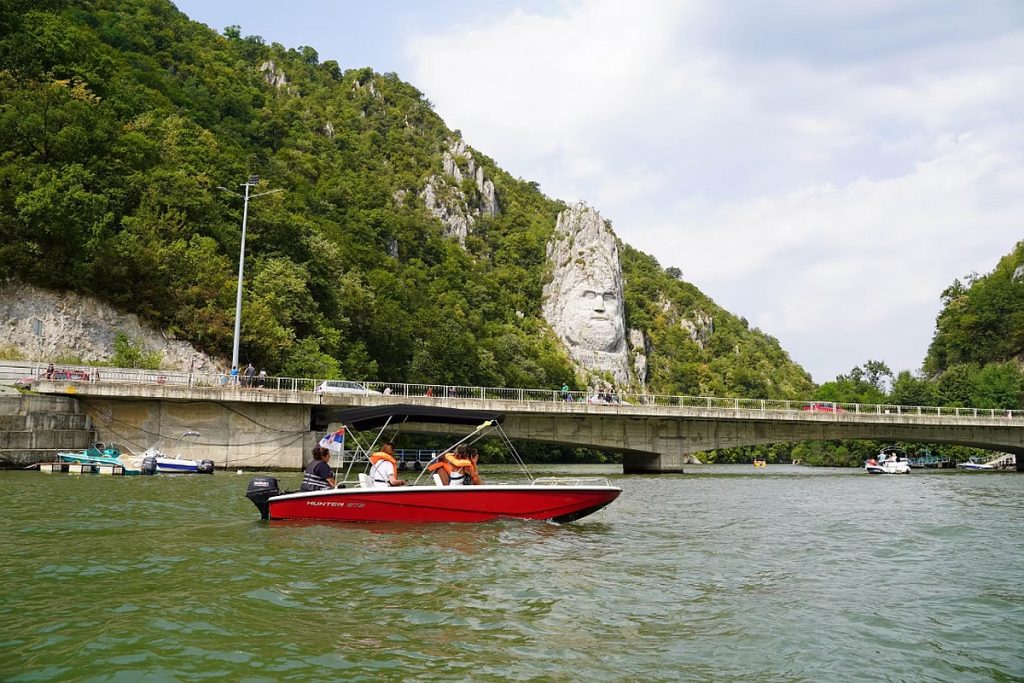
Crossing to the Serbian side, we visit Trajan’s Plaque (Tabula Traiana), a Roman Latin inscription carved into the rock, commemorating Trajan’s bridge and road, only visible from the river.
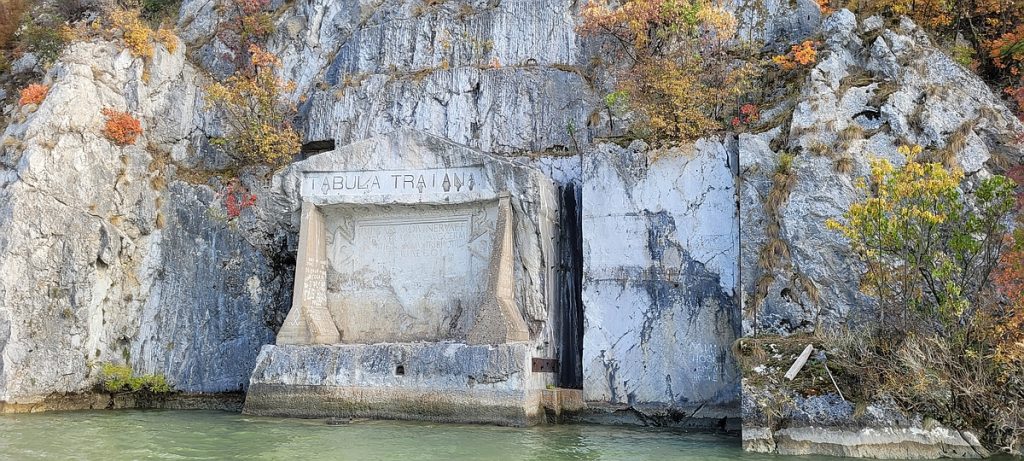
Before returning to our departure point, our final stops include the peaceful retreat of Hajdučka Vodenica and the historic signal balloon stations of Varnica and Pena.
Here we will end this river journey where history, nature, and legend meet—only on the Danube.
After enjoying the river, it is time to return to the vehicle and return to Belgrade in the evening hours.
Overnight: Belgrade
Day 5 (Friday): Eastern Serbia: Manasuja Monastery & Resava Cave
Your tour starts at your accommodation. We head towards Pomoravlje District, the center of the last Serbian Medieval Kingdom, where monasteries still preserve the enormous cultural and historical legacy and wealth.
Manasija Monastery
Our first stop today will be Manasija monastery, one of the last monuments to Serbian medieval culture, raised by Despot Stefan Lazarević, son of Prince Lazar. The church’s construction, extravagant fortification, and large refectory took from 1406 to 1418. The impressive walls with 11 towers, surrounded by a trench, have been a modern system for the monastery’s defense. The most dominant and imposing tower – the keep – is Despotova Kula (Despot’s Tower). The Church of the Holy Trinity is a prime example of Morava architecture. Frescoes in Manasija are among the most beautiful of the Morava properties and old Serbian art. Besides the monumental depictions of warriors in the choir transept, prophets pictured in the dome are fantastic, and the idealized representation of Despot Stefan Lazarević presenting a model of the church to the Holy Trinity. Besides the monastery, church, and fortifications, Manasija partially preserves the old refectory and library remains. The library housed a scriptorium in which numerous books were copied. The so-called ‘Resava orthography’ was much valued and influenced later scribes for some time to come.
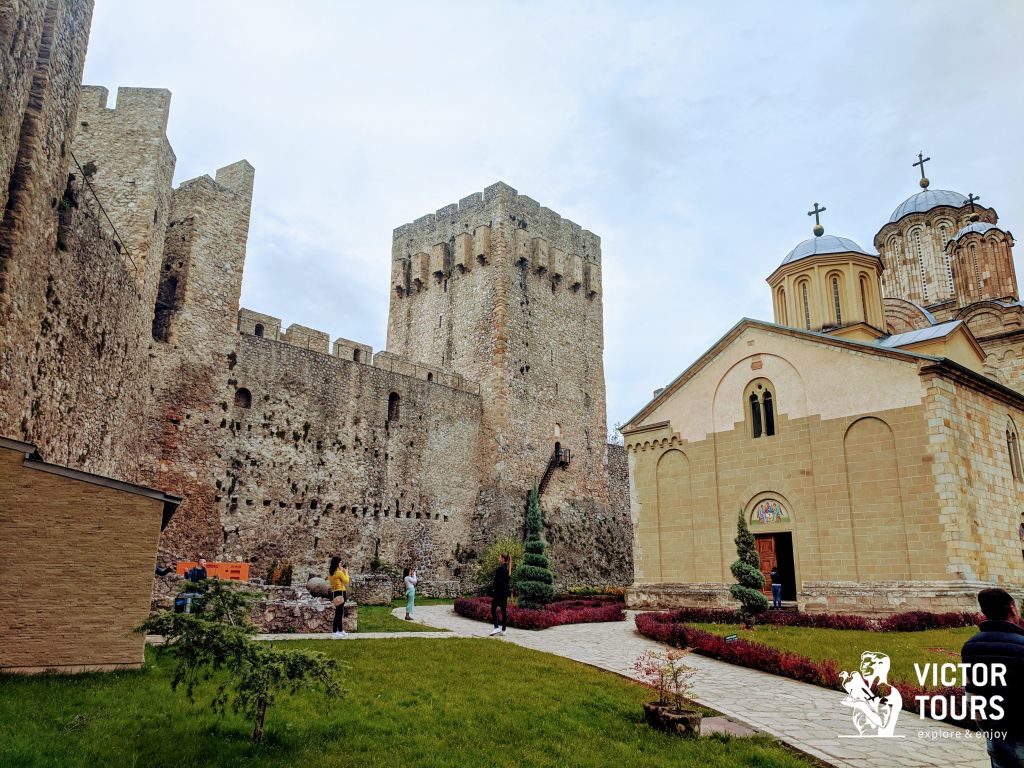
Resava Cave
Next, we are set for an extraordinary experience. We will visit the Resava cave, one of the oldest in Serbia, some 80 million years old, with some of the older formations dating back around 45 million years. The cave interior abounds in numerous and varied halls, channels, galleries, columns, stalactites, stalagmites, draperies, and flowstone waterfalls. The system consists of three levels connected by artificial tunnels. You will hear exciting stories about the cave’s past and present, and you’ll see cave formations that are coming in some very unusual shapes.
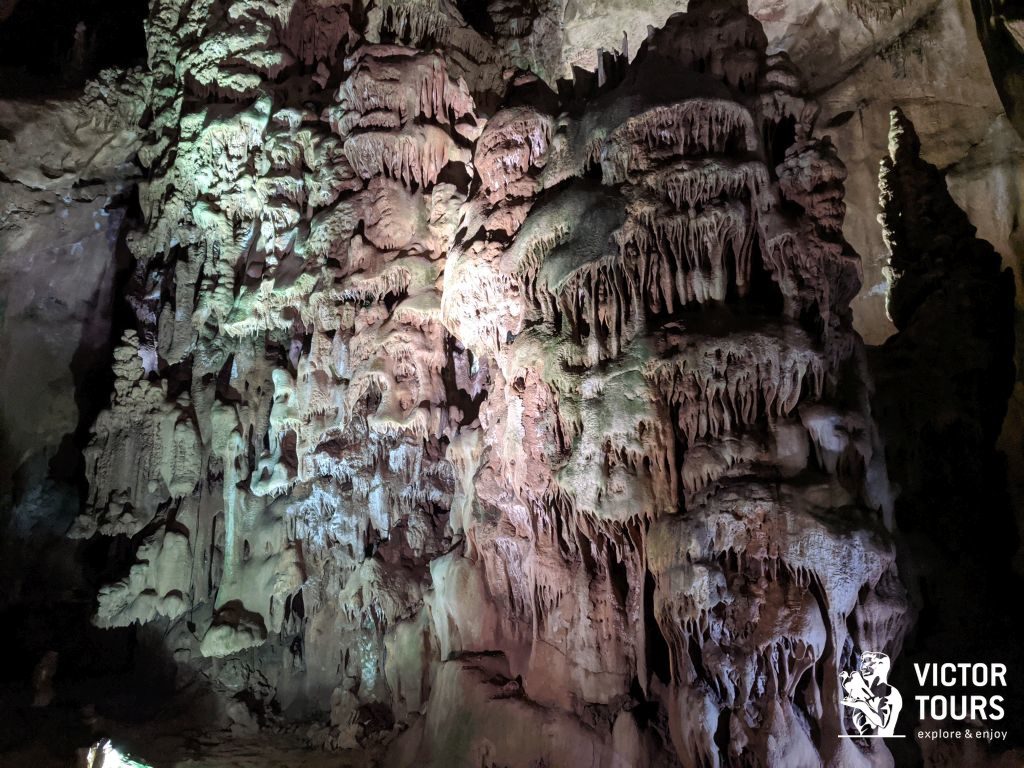
Veliki Buk waterfall
Our next stop is Veliki Buk (also called Lisine), a beautiful waterfall, approximately 20-25 high, making it one of Serbia’s highest waterfalls. The surroundings are scenic and perfect for relaxation. This karstic waterfall is protected as a natural monument, and it’s most impressive during the autumn. There’s less water in the summertime, but it’s still lovely to visit, and very refreshing. Further on, you will enjoy a traditional Serbian lunch in a unique atmosphere (not included in the price).
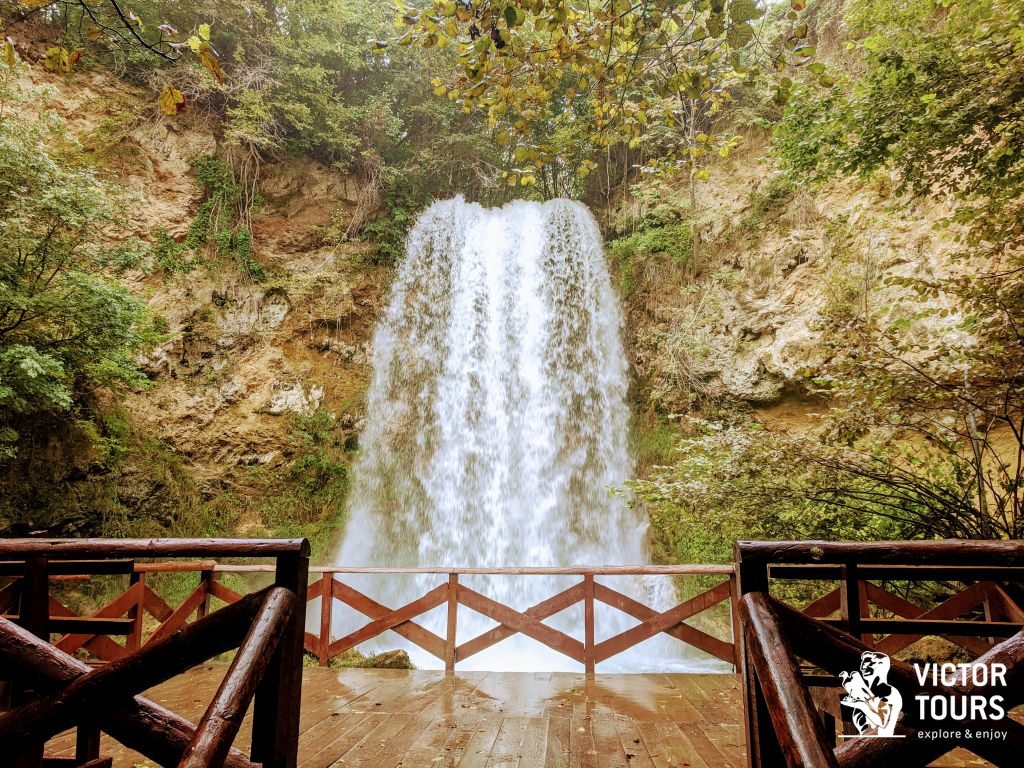
After an unforgettable day, you will head back to Belgrade. Your tour concludes with transportation back to your hotel in Belgrade, where we’ll arrive in the late afternoon. End of services.
Overnight: Belgrade
Day 6 (Saturday): Northern Serbia: Novi Sad & Sremski Karlovci
Your trip will begin with pick-up from your accommodation in Belgrade, and we will head toward the Northern Serbian province of Vojvodina.
An hour of our ride we will spend enjoying the colorful landscapes of the Pannonian plain and hearing stories about the turbulent history of this area.
Home to more than 25 ethnic groups, with six official languages in use, Vojvodina represents a diversity unheard of in the rest of the country.
Fine chernozem soils make Vojvodina the agricultural heart of Serbia, and the region supplies much of the country’s wheat and corn (maize). They have a saying in Vojvodina: “If you drop a button into the ground, next spring, you will harvest a full coat.”
FRUŠKA GORA: We reach Fruška Gora, the only mountain in this region, covered with woods and filled with vineyards on the lower slopes, one of 5 National parks in Serbia but also one of the oldest and best wine regions. The thick Lyndon forests served as a perfect hiding place for 17 medieval Orthodox monasteries that have nested within it.
Krušedol Monastery
Fruška Gora, or “The Serbian Holly Mountain,” as it is often referred to, is a home for 17 active Orthodox monasteries. The monasteries were founded during the period of wars and migrations caused by Turkish occupation. They became vital communities that ensured that Serbian identity and Orthodox religion would survive through difficult times. Founded in the early 16th century, Krušedol is probably the most important one. Despite the large-scale destruction on several occasions, some original paintings remain on the dome’s pillars, while frescoes and icons date back to the mid-1700s. The church contains the remains of many members of the Serbian noble Branković family, as well as King Milan Obrenović (died 1901).
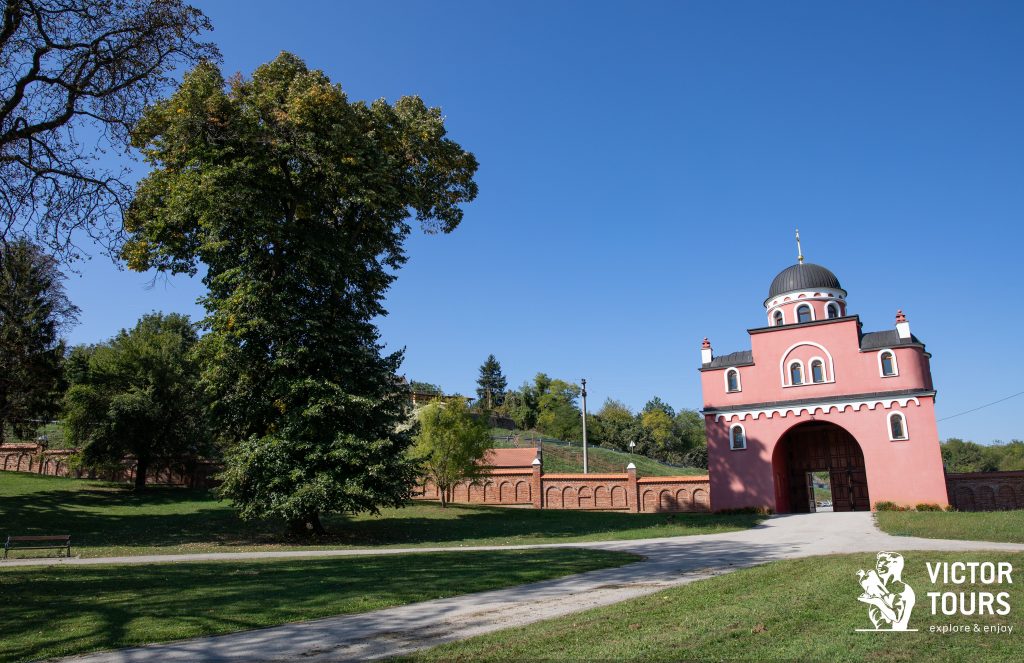
Sremski Karlovci
A quiet, Baroque town where time has stopped will impress you with its small houses, Baroque churches, palaces, gardens, and fountains. It also has an impressive history: in 1699, a peace treaty between Christian European forces and the Ottoman Empire was signed here, putting an end to the Ottoman conquest of Europe.
The town was a religious and educational center of the Serbs for more than 250 years, which makes it one of the most critical places in Serbian history.
First, we will visit the Chapel of Peace, where the peace treaty was signed. Then we’ll stroll through the streets of Karlovci down to the main square. Here we will see the Four Lions Fountain, The Karlovci Gymnasium (High School), the Town Hall, the Roman Catholic Church, the Serbian Orthodox Church of St. Nicholas, the Patriarchy, and the Serbian Orthodox Theological Seminary. In one of the oldest wine cellars in the city, we’ll taste the most famous product of the area: the Bermet wine.
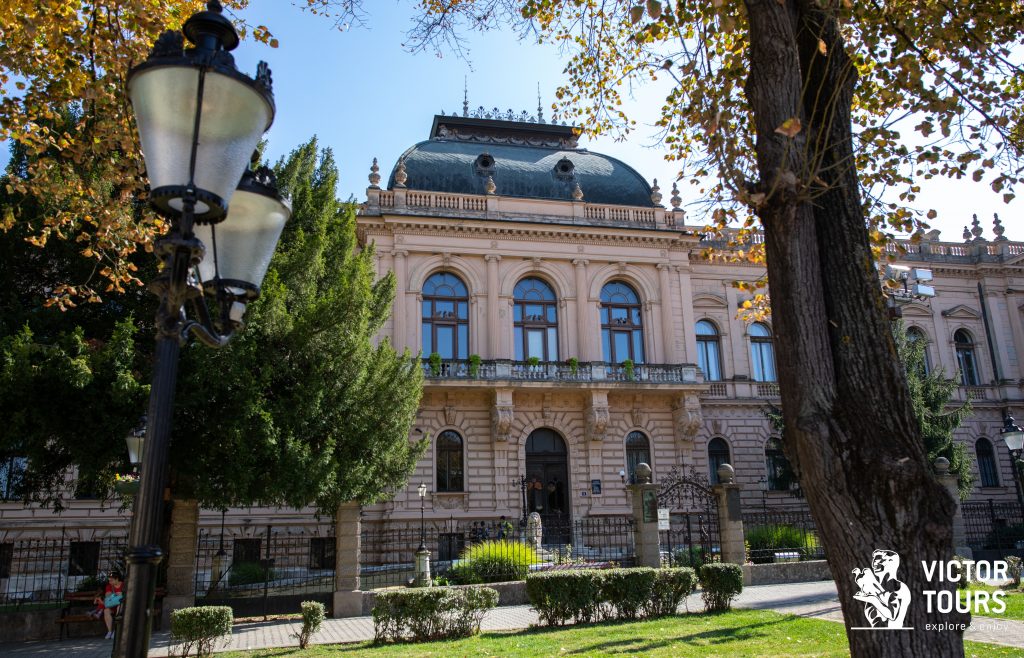
BERMET WINE TASTING: Our next activity will be Bermet wine tasting, for which this area is widely renowned. This picturesque town has a wine-making tradition longer than 250 years, so it is a perfect chance for us to get acquainted with the Bermet, a Serbian wine that even made it to Titanic.
Bermet is a unique kind of locally-produced aromatic dessert wine. Its delightful sweet taste is easy to underestimate, although it holds around 15-18% alcohol! Mostly prepared as red wine, it was quite trendy within the European royal families in the 15th century and was exported to the United States in the late 19th century. Even mighty Maria Theresa was fond of it.
We’ll hear stories about the history of wine-making in Sremski Karlovci, discover the secrets about Bermet production that every family keeps for themself, and we will learn why they say that Bermet is “the best wine for men, but when ladies drink it”.
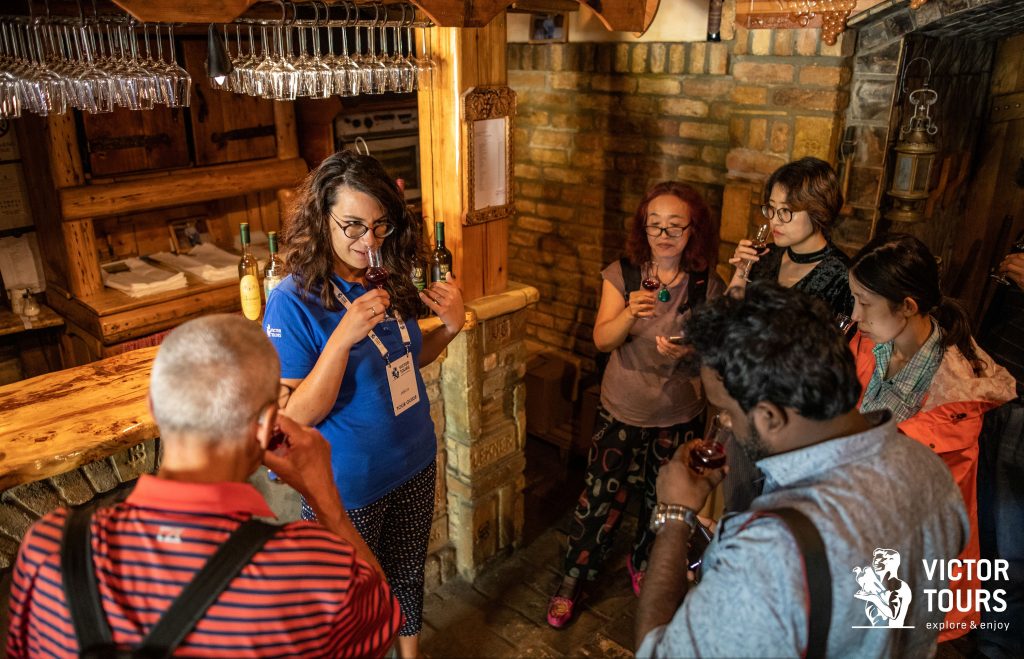
Petrovaradin Fortress
Next, we’ll visit the mighty Petrovaradin Fortress, nicknamed ‘Gibraltar on the Danube.’ One of the largest strongholds in Europe, still preserved, covers the surface of 100 ha. Built by the Austrian Empire in the 17th and 18th centuries, it played a significant role in defending the Middle European countries from Ottoman attacks. We’ll walk through the fortress, pass through some of its gates, and see the most exciting places on the top of it, like the City Museum, Old Military Barracks, and the Clock Tower. We’ll enjoy the view over the Danube and the city of Novi Sad.
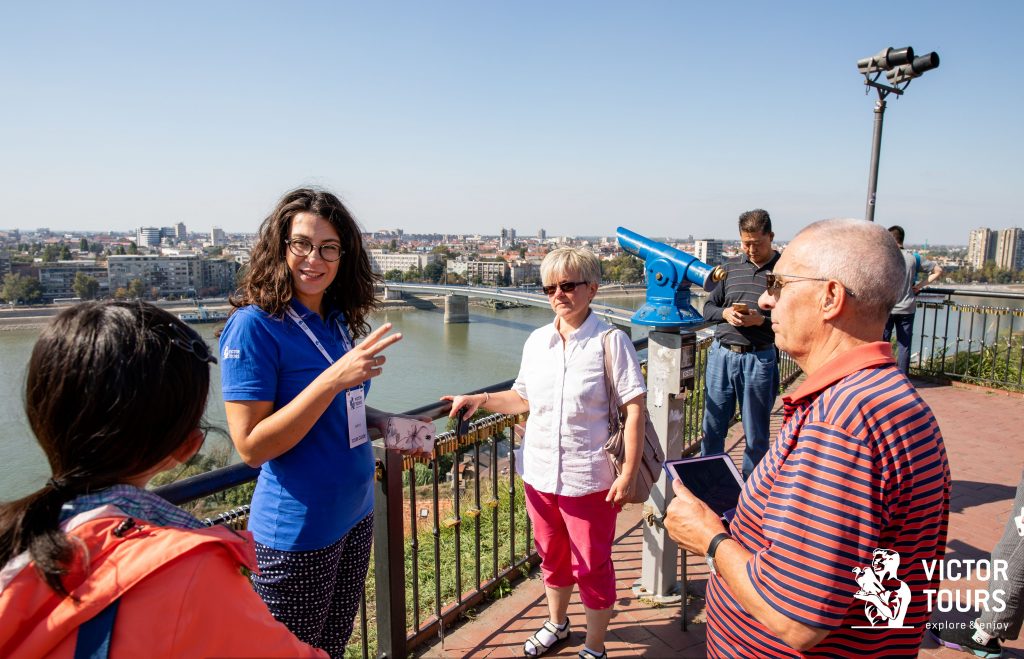
Novi Sad
Novi Sad is the second-largest city in Serbia, with its typical Middle European appearance and proud history of being a cultural and intellectual center of the Serbs in the Austro-Hungarian Empire, for which it earned a name – Serbian Athens. Here we’ll see the most famous sights: the Museum of Vojvodina and Dunavski Park – the largest green area in the city, and the beautiful Neo-Romantic Serbian Orthodox Bishop’s Palace. We will not miss the Serbian Orthodox Cathedral of St. George from the 18th century, with its valuable iconostasis painted by famous Serbian painter Paja Jovanovic. We’ll walk through the main street further on, enjoying the 18th and 19th-century architecture, as well as endless rows of cafes and restaurants, until we reach Liberty Square, a central point in the city. Here we’ll find The Town Hall, Roman Catholic Cathedral, Finance Palace, and the Neo-Classical edifice of the oldest city hotel called Vojvodina. Finally, we’ll pass by the Serbian National Theater and reach the city Synagogue, a beautiful Hungarian Secession-style building, one of the largest European synagogues to be preserved.
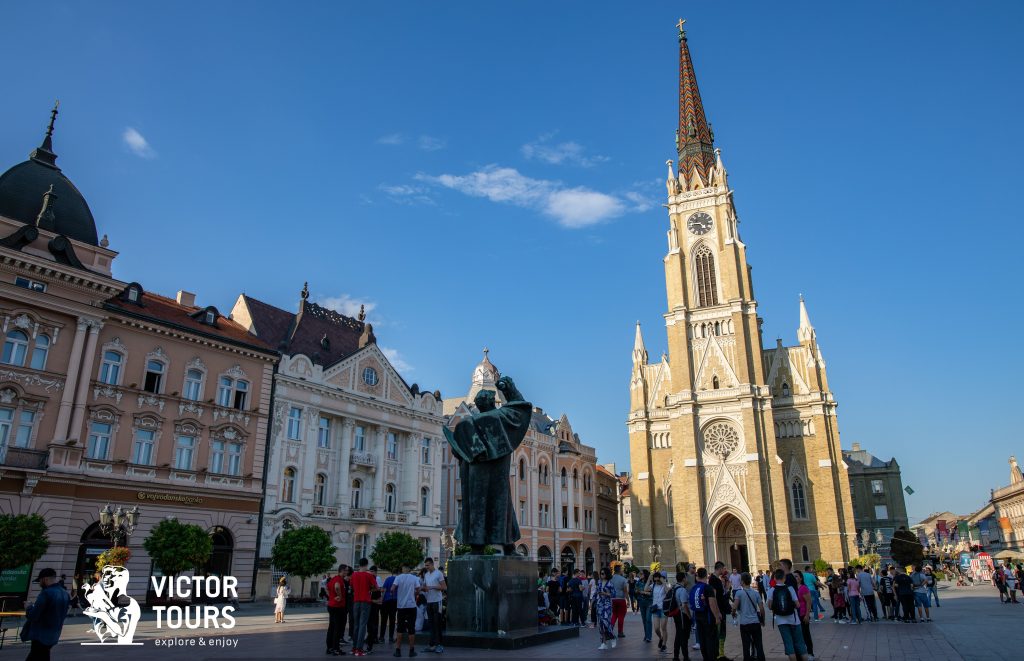
Free time / Lunch break
After that, we’ll take a break, and you can enjoy your free time in Novi Sad. Perhaps, take your guide’s advice for a traditional Serbian lunch (at own expense), go shopping, visit The Museum of Vojvodina, or wander around the streets of Novi Sad. At the arranged time, get back into the vehicle and head back to Belgrade.
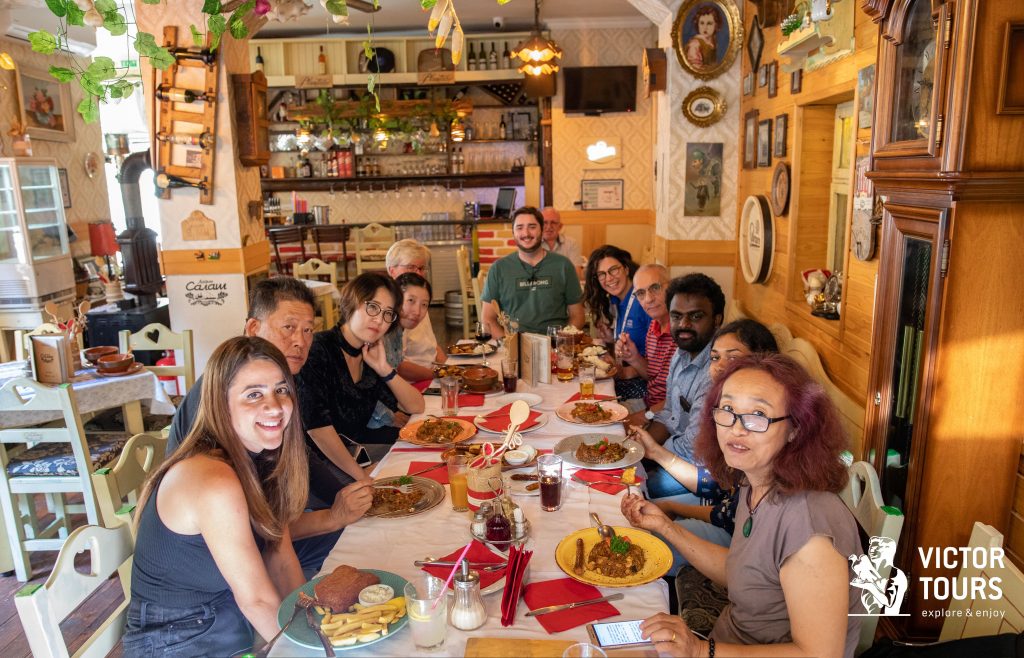
Your tour concludes with transportation back to your hotel/accommodation in Belgrade, where we’ll arrive in the afternoon. End of services.
Overnight: Belgrade
Day 7 (Sunday): Depart Belgrade & Serbia
Breakfast. Free time until your flight. Transfer to the airport for your departure flight. End of services.
IMPORTANT NOTE: If you want to stay in Belgrade a few days after the tour is finished, you can book additional nights with us, at the same hotel, for a surcharge of 50€ (Classic package) or 60€ (Upgraded package). Prices are per person, per night, in a double or twin room.
If you decide to extend your stay, your departure transfer will still be included.
Price
Every Monday, April 7th – October 13th, 2025.
Prices per person, small groups:
| PACKAGE | double/twin room | triple room | single room |
| Classic | 900€ | 800€ | 1,200€ |
| Upgraded | 1,000€ | 900€ | 1,350€ |
Classic package hotels: Mark, Nobel Palace, Royal Inn, Prag, or similar
Upgraded package hotels: City Savoy, Radisson Belgrade Art, Mercure Excelsior, or similar
Highlights:
PACKAGE INCLUDES:
- 6 nights with breakfast in a chosen category centrally located hotel in Belgrade, according to the selected package
- Arrival & departure airport transfers
- Tickets and entrance fees: Šargan Eight train, Wooden Town, Resava Cave, Veliki Buk (Lisine) waterfall, Golubac Fortress, Danube boat ride, St. Sava Temple
- Wine tasting during the trip to Novi Sad
- Sightseeing per the given itinerary in a modern, air-conditioned vehicle
- Services of English-speaking tour guides
- City taxes, VAT
- Tour organization and 24/7 support from a licensed incoming tour operator
NOT INCLUDED:
- Arrival and departure flights
- Food & drinks (except for breakfast in the hotels)
OPTIONAL:
- Bohemian night in Belgrade = 30€ per person (three-course meal, one drink, and transportation included)
CHILD POLICY:
- Child from 0 to 2 years old – FREE of charge.
- Child from 2 to 12 years old, sharing the bed – 50% discount on the price in a double room
- Child from 2 to 12 years old, extra bed – 30% discount on the price in a double room.
CANCELLATION POLICY:
- Up to 60 days before the departure date = 100% refund
- 59 days to 46 days before the departure date = 90% refund
- 45 days to 31 days before the departure date = 80% refund
- 30 days to 16 days before the departure date = 70% refund
- 15 days to 8 days before the departure date = 50% refund
- 7 days or less before the departure date = 0% refund
IMPORTANT NOTES:
- You MUST confirm and obtain any visa requirements prior to the booking. All visa requirements are the sole responsibility of the traveler. A current valid passport is required on the day of travel.
- Gratuities are not included in the price (not mandatory, but common)
- The final choice of hotels will depend on the availability at the moment of your booking. We reserve the right to change the hotel due to availability, but we promise the same category, location, and level of quality
- The minimum number of guests required for the tour to departure is three.
- Tour duration: seven days
REVIEWS:
Looking for tours beyond just Serbia?
Explore tours going through multiple countries, including Serbia.

